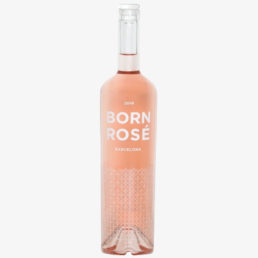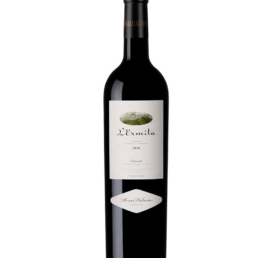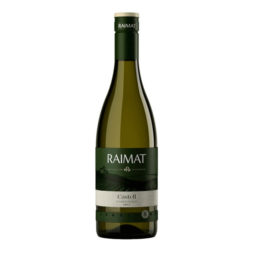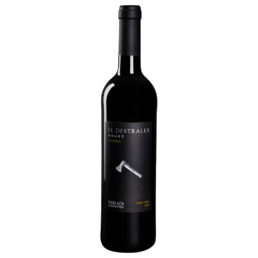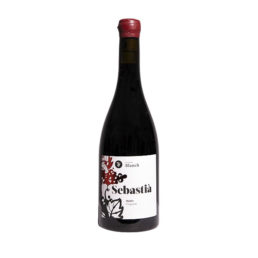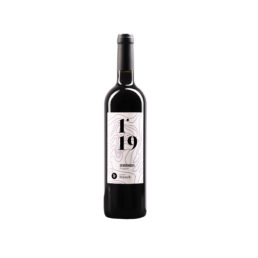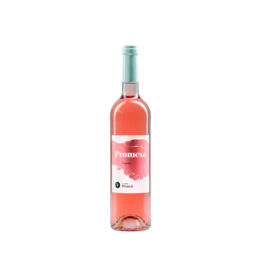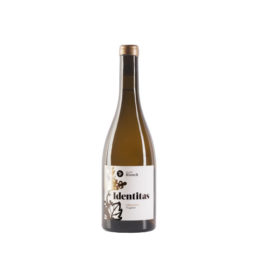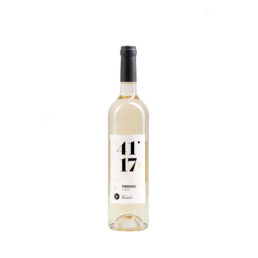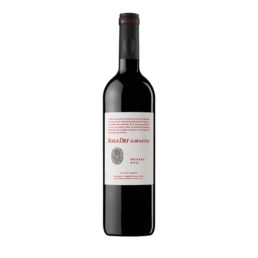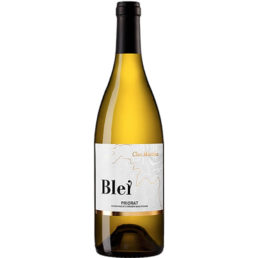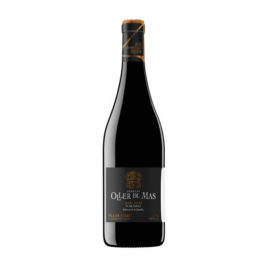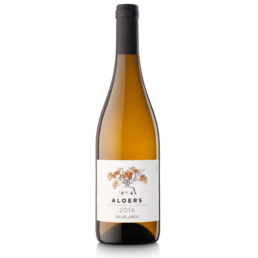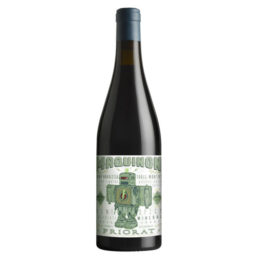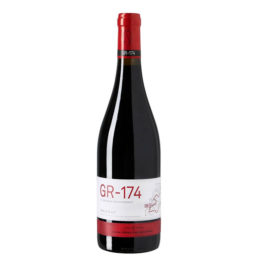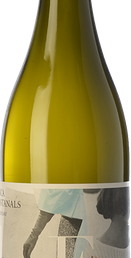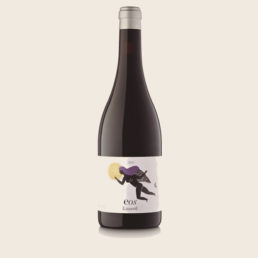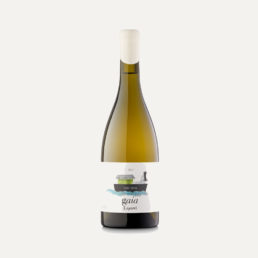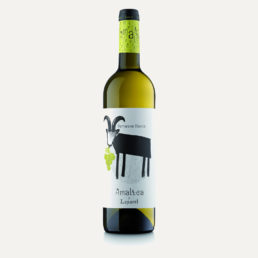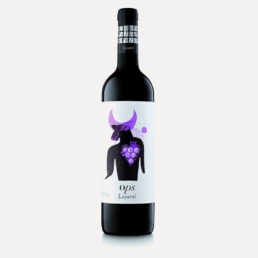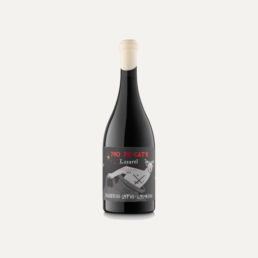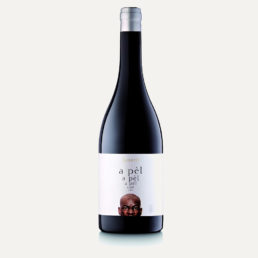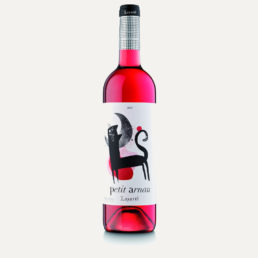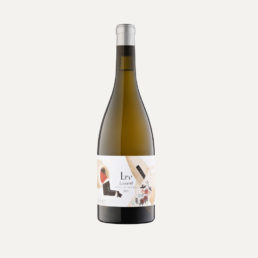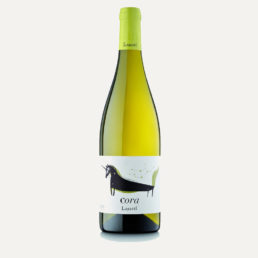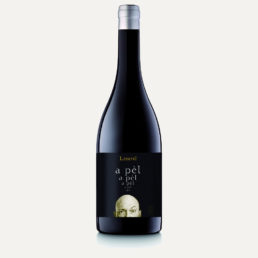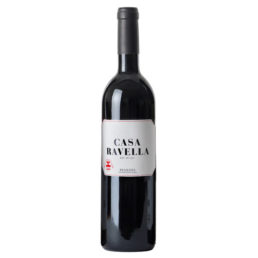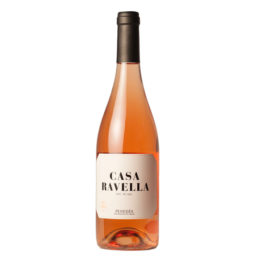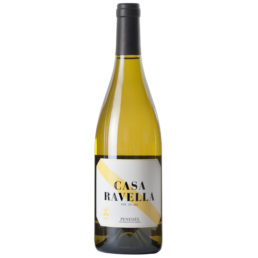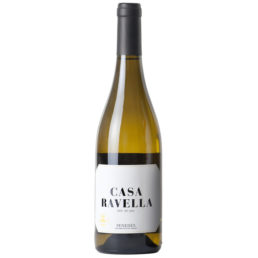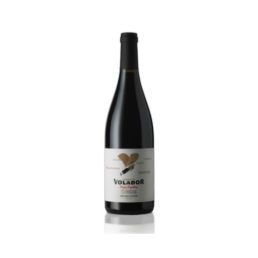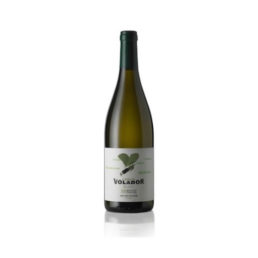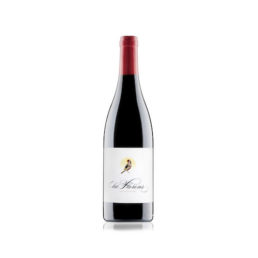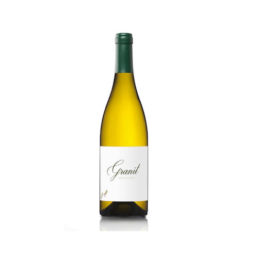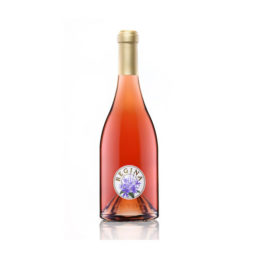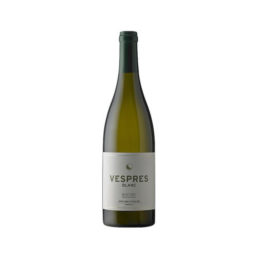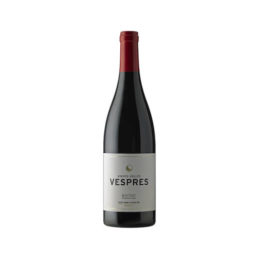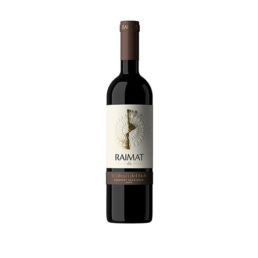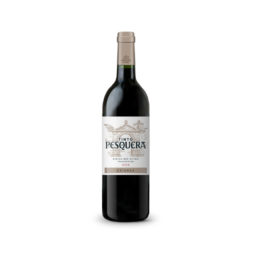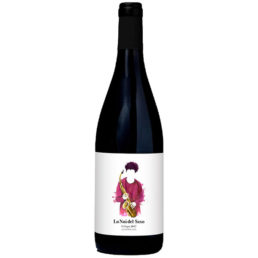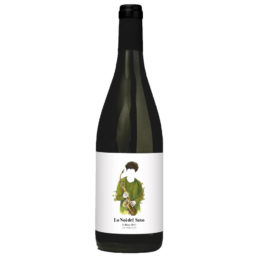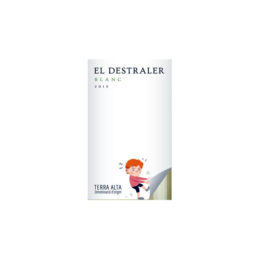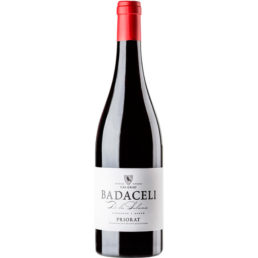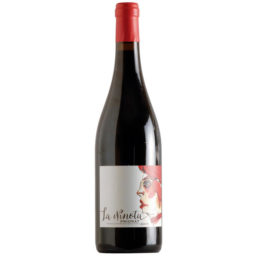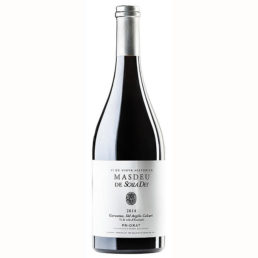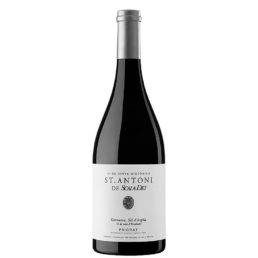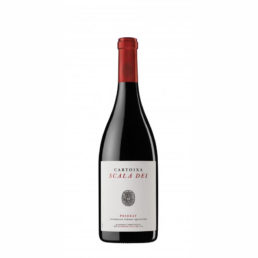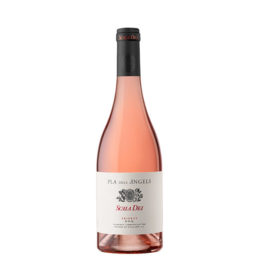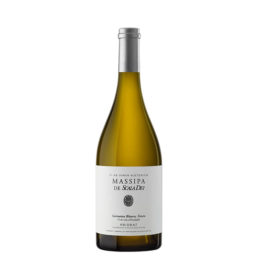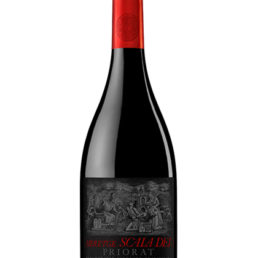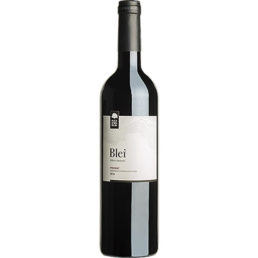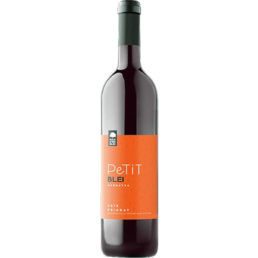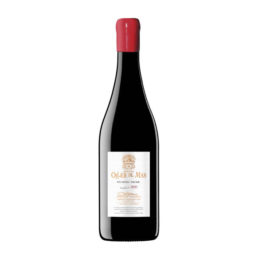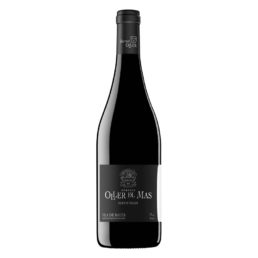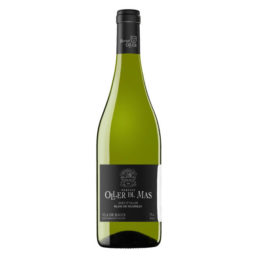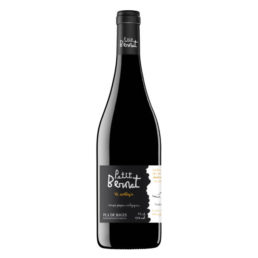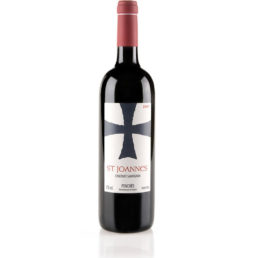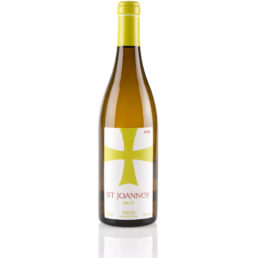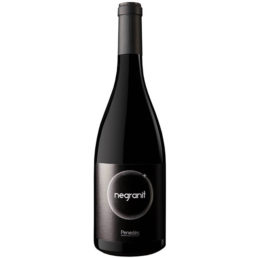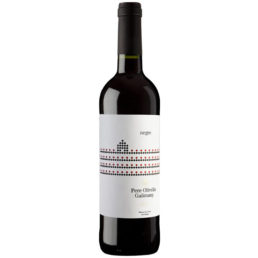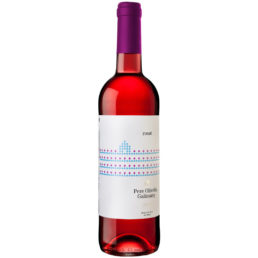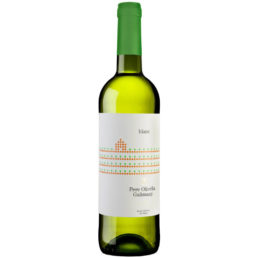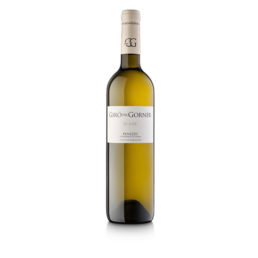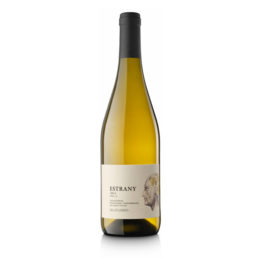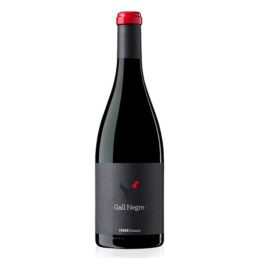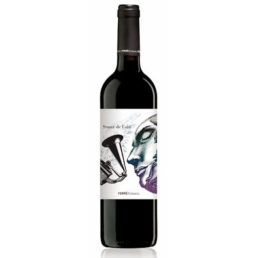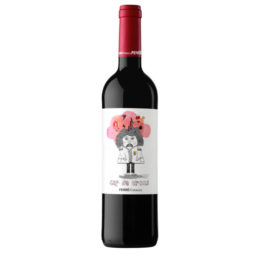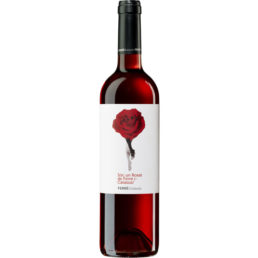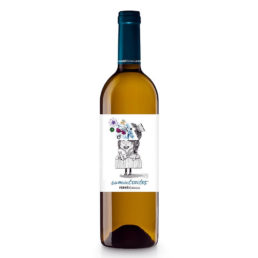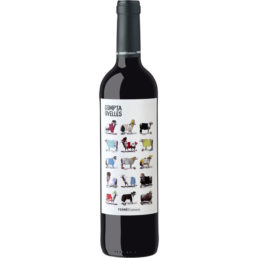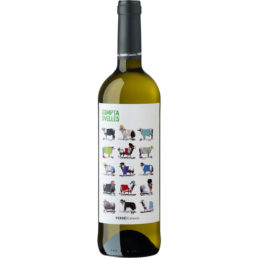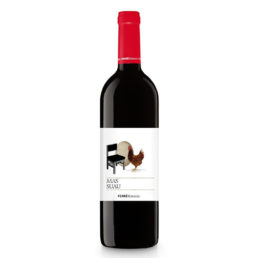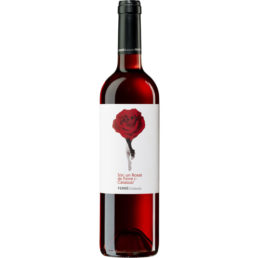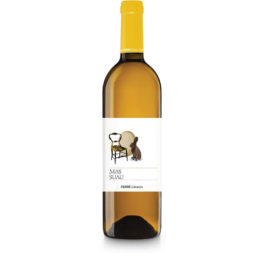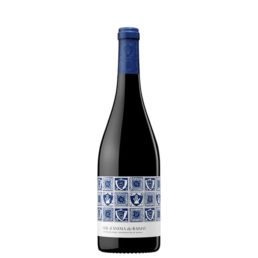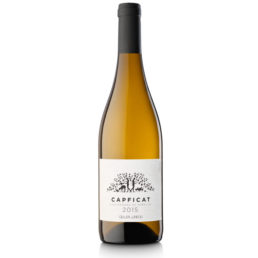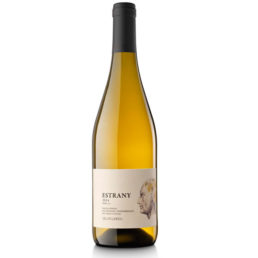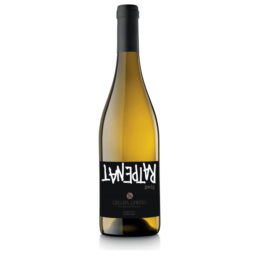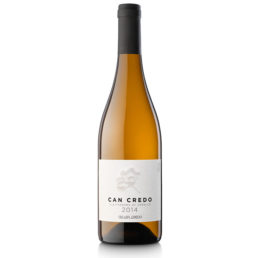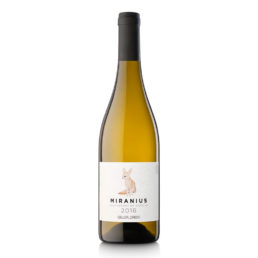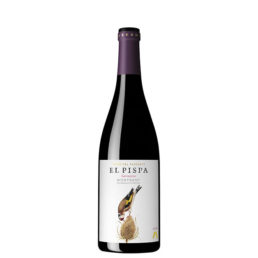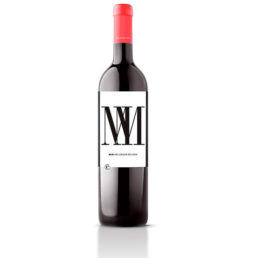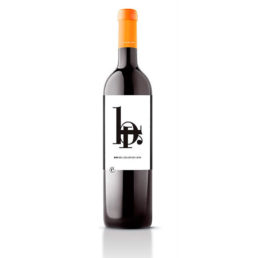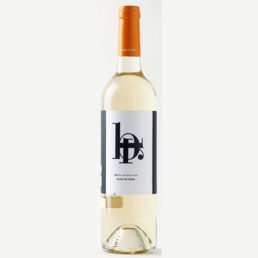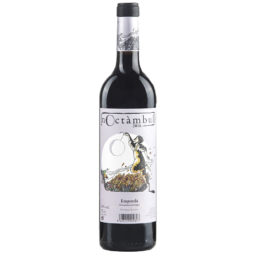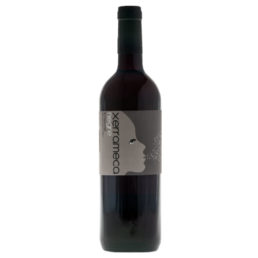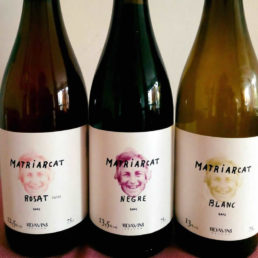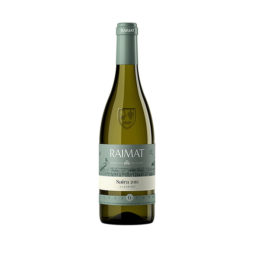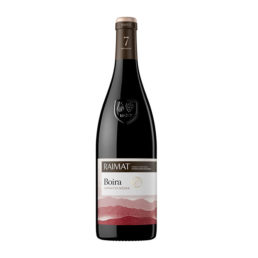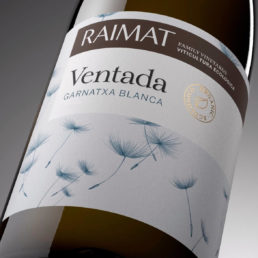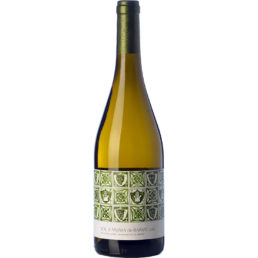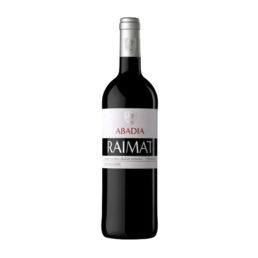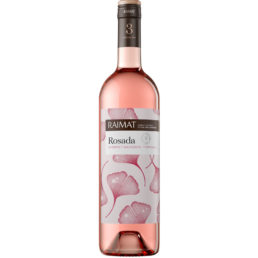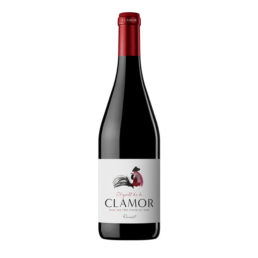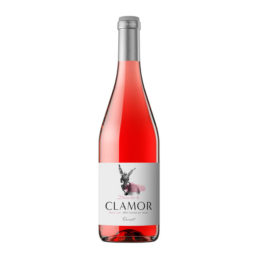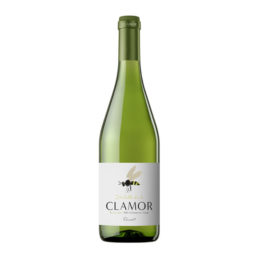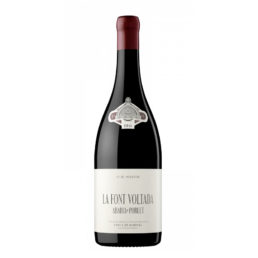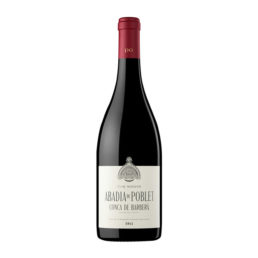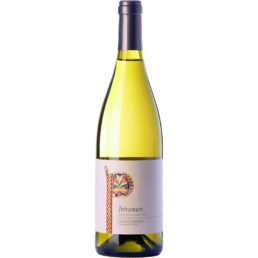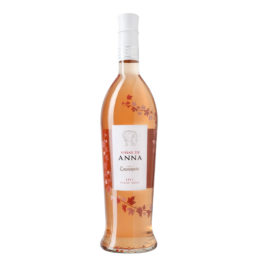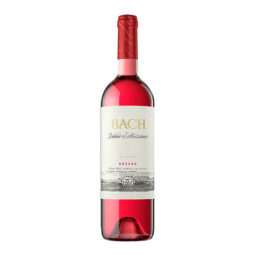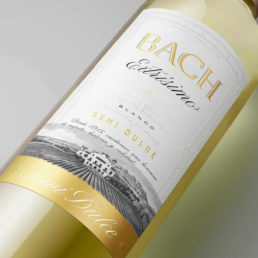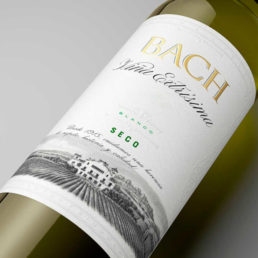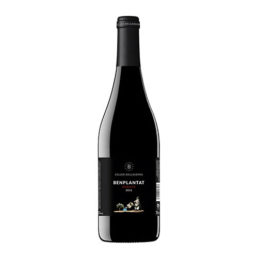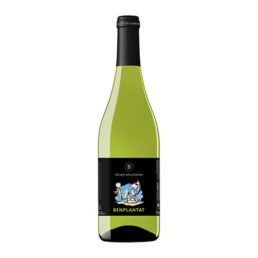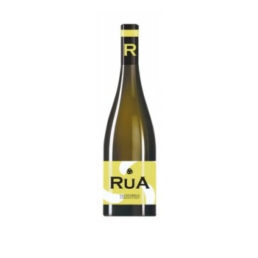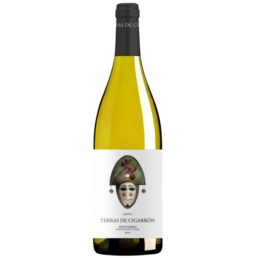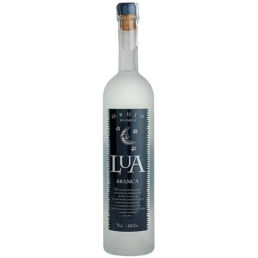VINIFICATION Pre-maceration in cold during 24 hours. Pressing to racking to a tub where it is kept other 24h. Fermentation in new French oak barrels (Q. Petrea) of 300 liters, fine grain and medium toast light. Parenting 6 months with lees and "battonage" journal. Stabilization in cold, the natural way (seasonal), not induced. Bottled: 1 year in the bottle.
AWARDS GOLD medal INTERNATIONAL WINE CHALLENGE 2016.Wines of Catalonia
-
Álvaro Palacios Wine L’Ermita 2014 – 2015
Álvaro Palacios L'Ermita 2014 , red wine made by Alvaro Palacios from the Priorat area (Spain)Rated with the mythical 100 Parker points in the vintage 20013, L'Ermita is one of the great oenological jewels of the Spanish scene with which Álvaro Palacios has managed to be at the top in terms of recognition.. -
White wine – Petit Bernat 2018
White Wine Petit Bernat 2018Production: 24.267 bottles Wine:Pressing, clarification, fermentation and rearing on mothers. Cold maceration before pressing. Alcoholic fermentation of 21 days at 16ºC.Oller del Mas is part of the Denomination of Origin Pla de Bages, a privileged area, surrounded by mountains like Montserrat, or the Parc Natural de Sant Llorenç del Munt i l'obac. -
White wine Raimat Castell Chardonnay
Chardonnay is the varietal emblematic of Raimat. Crafted from the years 70, Chardonnay Raimat offers white wines, very aromatic, complex, fresh and fruity. Raimat Castell is the dream of a visionary, and his castle is the memory. A shield engraved in stone, found over one hundred years ago on the entry door shows a bunch of grapes and a hand. This symbol became the origin of the name Raimat (“Raïm”, grapes in Catalan, and “mà”, hand) and in the image of the brand. With Raimat Castell, we commemorate the origins of Raimat who endure with steadfastness as the walls of his castle.DEVELOPMENT (VINIFICATION)The Chardonnay is gathered in three phases: the first with a potential alcohol of the 12% (to get the citrus flavors), the second with 13% (tropical flavors) and the third time with potential alcohol of 14% (flavors of ripe apricots). The grape arrives during the night, fact that allows it to reach low temperatures, to preserve the aromas of the variety and avoid oxidation of unwanted. Is performed a pressing immediate, to then make a natural clarification at low temperatures during 24-48h. Once clean, the wort, is decanted into a stainless steel tank with cooling system for performing a controlled fermentation between 16-18 ºC. After the alcoholic fermentation, the wines are preserved in tanks, avoiding oxidation, until the time of bottling. Thanks to the possibility of being able to harvest in a step-like manner, you get different styles of Chardonnay. The blend consists in mixing these styles to give complexity to this wine white, without straying from the initial goal: to maintain the expression of the fruit and the freshness.PAIRINGRaimat Castell Chardonnay is the perfect complement to dishes containing white meat, fish, shellfish, rice, folders, and salads.PRIZES ADD 2017GOLD MEDAL MUNDUS VINI - 2018 -
Red wine Celler Germans Balart – The black ax raised by Magnum
Tasting notes: CELLER GERMANS BALART - THE BLACK ADVANTAGE BREADS MAGNUM
- Nose: Balsamic Aromas, cherry, Vanilla and cocoa.
- Mouth: Powerful, silky and round
-
Cava Brut Nature Subirat – Cellers Blanch
Cava Brut Nature Subirat
Production: 2000 bottles (75 cl.) -
Sebastiá Red Wine – Cellers Blanch
Vineyard: Finca "Cosi" , manual harvest and ecological treatment in the Puigpelat area (Alt Camp, Tarragona).Fermentation: Selection of the best grapes for fermentation with their skins during 23 days and subsequent aging for 12 months in french oak boots. Subsequent aging in bottle minimum 6 months.Production: 600 bottles (75 cl.) -
Coordinated Red Wine 1º19 – Cellers Blanch
Vineyard: Finca of more than 20 years in the Puigpelat area (Alt Camp, Tarragona), manual harvest and ecological treatment.Fermentation: The first weeks it is macerated with its own skins, without adding sulfites, while performing the pissage technique. Subsequently, the fermentation continues in stainless steel tanks.Production: 1800 bottles (75 cl.) -
Promise rosé wine – Cellers Blanch
Vineyard: Farms of more than 20 years in the Puigpelat and Pla de Santa María areas (Alt Camp, Tarragona), manual harvest and ecological treatment.Fermentation: Fermentation takes place in steel tanks after joint pressing., making the coupage in grapes instead of once fermented generating a character of its own.Production: 500 bottles (75 cl.) -
Identitas white wine – Cellers Blanch
Identity it is a single varietal white wine, 100% Subirat Parent from Finca Bastards. Very expressive wine, elegant and sophisticated on the nose, while on the palate it is dry and creamy with fruity nuances.Vineyard: Finca "Bastards" of more than 60 years old, manual harvest and ecological treatment in the Puigpelat area (Alt Camp, Tarragona).Fermentation: Selection of the best grapes for fermentation in chestnut boots, during 3 months I work with his lees using the battonage technique. Subsequent minimum aging 6 months.Production: 1000 bottles (75 cl.) -
White wine Coordinates 41 17 – Cellers Blanch
Coordinates 41 17
Vineyard: Finca "Les Rengles" of more than 40 years old, manual harvest and ecological treatment in the Puigpelat area (Alt Camp, Tarragona).Fermentation: It is made in stainless steel tanks separately, so that each variety maintains its characteristicsProduction: 1.800 bottles (75 cl.) -
Red wine, Scala Dei Garnatxa
Vineyards planted on terraces and the typical "Costers" slate of Priorat, between the ages of 15 and 25 years located in altitudes ranging from 500 until the 800 meters above sea level.DEVELOPMENT (VINIFICATION)The development of the Grenache Scala Dei is done in small open vessels, by groupage of grapes homogeneously mature. Once the fermentation and using wine-tasting decides the moment of pressing. Once developed, the wine remains 6 to 8 months in stainless steel tanks until its bottling.VINEYARD (VITICULTURE)This red wine is nourished mainly from the following vineyards: Maset, Stop, Closos, Escorial and Forsans, the D. O. Q. Priorat. Specifically, we look for grapes with a high acidity, a concentration of fresh fruit without sobremaduraciones tannin and a live but mature. It is a wine based on the Grenache. This wine aims to basically three things: freshness, fruit and simplicity. -
Scala Dei Prior Magnum tinted wine
Scala Dei Prior is a wine with personality, that breathes tradition and authenticity, since that allows to know better the richness of the D. O. Q. Priorat. It is elaborated with grapes from different small plots, carefully selected. This care durantand all the processing result to a Crianza wine is well structured and full of aromas that will transport you to the vineyards of the Priorat.DEVELOPMENT (VINIFICATION)After defining the vineyards that are going to go for this wine, the grapes previously selected in the estates arrive at the winery in small boxes 16 kg, where all the grapes is reviewed thoroughly by the warehouse staff as they pass through the selection table, vibratory installed at the entrance of the winery. After de-stemming and crushing, fermented at controlled temperature to preserve the aromas of ripe fruit. Later, the breeding takes place in barrels (French oak 80% and american 20%) during a year. This type of ageing is completed in bottle for more than a year for the wine to reach the market in optimal time of consumption.VINEYARD (VITICULTURE)Grapes from varieties of historical of the area and of the vineyards older (between 35 and 60 years old), planted on the terraces and in the typical “costers” licorella from Priorat. The terrain, the driving of the plants and above all, the desire to obtain the best grapes, makes the grape harvest is done manually only. The vineyards are situated between the 500 and the 800 meters of altitude, which favours the maturation is slow and regular and enables a variety of shades to combine heights and different orientations of the vineyards. All this makes this wine unique.AWARDS94 POINTS GUÍA GOURMETS 201890 POINTS GUIDE PEÑÍN 2018GOLD MEDAL MUNDUS VINI - 201890 POINTS ROBERT PARKER 2018GOLD MEDAL EXPOVINA - 2017SILVER MEDAL BACCHUS - 2017 -
White wine Mas d'en Blei – Clos Martina Magnum
PRODUCTION 4.000 bottles.VITICULTURE Grapes are produced only of the finca Mas d'en Blei. Vineyards on terraces of slate (licorella). Vintage hand. Selection in table. Development separated by varieties. -
Red wine – Arnau Oller, Selection of the Magnum family
Production6.446 bottlesWinemakingFermentation of 10 days at 22 ° c with llevaduras own Farm. Maceration of 15 to 30 days with two pumping over daily. Not used press.FosterBoots new oak French d'allier, Tronçais, and Nevers of 300 litres for twelve months. Subsequent aging in bottle in the cellar for a minimum of twelve months. Natural cork stopper in the country. -
White wine Celler Credo – Aloers Magnum
It was called ‘Aloers’ to the farmers of the Middle Ages who were the owners of the land that they cultivated. The aloers were free of any provision or census.The white wine Aloers come exclusively from the family vineyards of the Pedra Blanca, located in the comarca of the Alt Penedès (Barcelona) and cultivated following the principles of organic farming and biodynamic.We work the vineyards, leaving to grow a ground cover spontaneous, important to fluff up the soil and regulate the retention and the drainage of water in a rainfed cropping as we practice.This cover is essential to promote biodiversity and balance in the ecosystem of the vineyard, where we apply treatments with medicinal plants (phytotherapy) to control the presence of fungus and strengthen the strains of a totally natural way.The grape harvest at Celler Credo is carried out by hand to ensure the excellent quality of the clusters.Aloers provides the freshest and most genuine expression of the Mediterranean variety Xarel lo grown in calcareous soils.. It is a wine of great vitality and a long journey in a bottle.Produced from the maceration for a few hours with the stalks and to work with the lees during the time of approximately a month and a half. The fermentation takes place with yeast own from the vineyards of Celler Credo.Aloers look for the maximum expression of the terroir and, therefore, you can present natural sediments the result of a minimal intervention. The vinification and the bottling are done in our property. -
White wine Flight of the soul by Raimat Magnum
Vol d Ànima, formerly known as Ànima de Raimat, it is the culmination of our first 100 years of history. The tiles that dress up your tag are the same that look in the walls of the castle of Raimat from 1935, after the reform carried out by the architect Rafael Masó. This creation represents the soul of Raimat: a young red wine, modern, fresh, medium-bodied, with notes of cocoa, developed with the 3 red varieties that best express the terroir cellar: Cabernet Sauvignon, Tempranillo and Syrah.DEVELOPMENT (VINIFICATION)It starts with a grape harvest at night to preserve the primary aromas of the fruit.When the grapes reach the cellar, is cooled to a temperature of 15 ºC.A part of the grape is vinifica looking for a profile of the wine more fruity and fresh. Is achieved by keeping the temperature low for 24-48h and fermenting later 25 ºC. The other part of the grape is fermented at a higher temperature for greater texture and complexity in the wine. These two styles came together we offer a young red wine, modern, with lots of fruit and structure in the mouth.PAIRINGVol d Ànima de Raimat Red wine can accompany well to dishes of hunting, mushrooms, meats and legumes, as well as sausages and rice. It is a wine that is very versatile. -
Red Red Wine House – Maquinon
The strength of the Priory in a wine and a grape, Black Garnacha, transmitting a piece of this land, clearly defined by its terroir: the blackboard (llicorella).From vineyards over 10 years old, located in different terraces. Limited production 18.000 thousand bottles. -
Vino tinto Tinto GR-174
Description of Red Wine Red GR-174
It is the expression of farms. In it involved the two terroirs, one (Casa Gran) bringing much freshness and red fruits and the other (La inviolability) with minerality, structure and black fruit.It is made with all grape varieties from the two farms: Grenache, Cabernet Sauvignon, Samsó, Syrah, Merlot and Cabernet Franc. -
Vino rancio Finca Fontanals – Rancid Old Priory House Castle Montsant
In the region of Catalonia has a long tradition in wine Oxidative specifically rancid wines Grenache (we RANCIER), which traditionally they have been prepared for centuries by many families for their own consumption. -
White wine Finca Fontanals – Finca Fontanals
Elaboration:Winemaking equipment: Stainless steel / WoodRearing period: 4 monthsAge of the barrels: NewWood type: OakProduction: 500 bottles -
Vino tinto Finca Fontanals – Finca Fontanals
Elaboration: A perfect cupage where each variety gives the wine different characteristics perfectly complemented, the freshness of the Garnacha, Merlot brings softness with maturity and complexity of Syrah and Cabernet Sauvignon. Wine made from a certified organic viticulture CCPAE (Catalan Council of organic farming, corresponding certification both the farm, the vineyard, as well as the winery and the wines). From vines planted on land belonging to the family for several generations, 8 hectares of vineyards located in the municipality of Falset districito, within the DO Montsant, while limiting the Priorat DOQ, and it is composed of three different types of soils, sandy loam, Red sandstone and calcareous Llicorella. Vintage manual, fermentation with natural yeast in stainless steel 2000 liters. Parenting during 8 months of each variety separately, continuing with other 6 months after the end cupage in French oak barrels of 1st and 2nd use. -
Red wine Loxarel – EOS Loxarel (ecological)
ElaborationViticulture, organic and biodynamics.Organically grown vines located on the highest point of the Alt Penedès, 700m above sea level. These vineyards provide well-structured wines with good rankings. Carbonic maceration getting Syrah varietal notes. Aging during 10 months in French oak barrels.PairingIdeal with all types of meat, especially a la flavored hot, duck breast and cheeses. -
White wine, Loxarel – Gaia de Loxarel (ecological)
Elaboration
Viticulture, organic and biodynamics.Elaborated with grapes 100% ecological vineyards to 700 meters that give freshness and acidity, this wine is fermented partially in jars of clay, and in barrels of chestnut for more creaminess and density in the mouth. Gaia represents in Greek mythology the Mother Earth, the origin of life.Pairing
Fish on the grill or in the oven. Rice and pasta with fish sauce. Seafood Stew, salad a little spicy. -
White wine, Loxarel – Amaltea de Loxarel (ecological)
Elaboration
Viticulture, organic and biodynamics.Grenache from the high zone of the Penedès, more than 500m of altitude over the sea level. Xarel lo from the Can Mayol estate, to a 250m altitude. According to Greek mythology, Amalthea is a nymph represented as the goat that suckled Zeus. The goat, the horn, the constellations are the basis of biodynamic agriculture.Pairing
Warm salads, rice dishes of fish and white fish. Cold starters, pica-pica. Wine social. -
Red wine Loxarel – OPS de Loxarel (ecological)
Elaboration
Viticulture, organic and biodynamics.Aged in amphorae of clay 720 litre of capacity for 3 months without going through wood in order to respect and preserve the varietal aromas.Pairing
Ideal for barbecues and meat flavored. -
Red wine Loxarel – 790 Pe-Cat’s of Loxarel (ecological)
ElaborationA wine with history. 790 are the days of long wait, from the harvest to the day it was bottled, coinciding with a day fruit of the biodynamic calendar. Alcoholic fermentation and malolactic fermentation in jars of clay 720 liters. Later, refined in barrels of 500 liters of French oak during 10 months. The 790 PE-CAT'S (harvest 2015) it is the natural evolution of this wine according to the wine cellar. We present a new wine, with a developing and different style, that corresponds to the current work that is being done in the winery with the will to advance towards the purest styles, looking for the expression of the grape and of the terroir in our bottles.PairingBraised meats (civet of wild boar, veal with mushrooms, grilled rib-eye pepper); creamy cheeses and dark chocolate. -
Red wine – To Pèl of Loxarel (ecological)
Elaboration
Viticulture, organic and biodynamics.Three months in barrels of 500 liters and three months in amphorae of clay 720 litre capacity. In order to find the expression of the varieties, intensity, territory and authenticity. Vineyards of Garnacha of height more than 500m above sea level, and Merlot, finca Can Mayol, to a 250m altitude.Natural wines are made with great work in the vineyard and minimal intervention in the winery.Pairing
Red meats and white with no sauces strong. All types of birds, especially partridge. Rice mountain. -
Rosé wine Loxarel – Petit Arnau de Loxarel (ecological)
Elaboration
Viticulture, organic and biodynamics.Fourteen hours of cold pre-fermentation maceration with the grape skins to extract the color ruby natural. The vineyards themselves are located in the Alt Penedès, at an altitude of 500m above sea level.Pairing
Accompanies very well with rice and meat and creamy (risotto), sausages and pasta. -
White wine, Loxarel – LXV of Loxarel (ecological)
Elaboration
Viticulture, organic and biodynamics.From vineyards situated in the municipality of Les Cabanyes (Alt Penedès), to 5 km of Vilafranca and 250m of altitude on the sea level. Mashing with part of the grapes whole. The grape skin provides us with protection, structure, aromas and complexity.Pairing
The majority of fish little spicy or with white sauces, especially tuna or salmon. Appetizers and rice dishes. -
White wine, Loxarel – Cora (ecological)
Elaboration
Viticulture, organic and biodynamics.From the vineyards themselves are located in the Alt Penedès, at an altitude of 500m above sea level. The Xarel lo comes from our farm in Vilobí del Penedès, in what is known as the Xarel·lo Triangle. Maceration with the grape skin during 6 hours, with carbonic snow, in order to respect the aromas and prevent oxidation.Pairing
Ideal to accompany appetizers, was, oysters, shrimp cocktail, fish and rice. In general, it combines very well with all mediterranean cuisine. -
White wine, Loxarel – A Pèl blanco xarel lo 10% amphora (ecólogico)
Elaboration
Viticulture, organic and biodynamics.Xarel lo from the Can Mayol estate, located at 250m of altitude. Manual harvest in boxes, choosing the healthiest grain and treating it with much care. Fermentation during 4 weeks in tanks with the whole grain with the skin of the grape where you will find them protective and tannins that prevent the oxidation. Later resting in jars of clay 720 litres for 3 months. Wild yeasts. Contains No sulfur dioxide added. Has not been subjected to any treatment, clarification or filtration.Natural wines are made with great work in the vineyard and minimal intervention in the winery.Pairing
By its structure and complexity, invites you to take it only. Ideal for sharing with the curious and wine lovers. Recommended to accompany dishes of japanese cuisine (sushi). -
Red wine Casa Ravella – Casa Ravella Tinto Crianza
SOURCEAlt Penedès. Penedès denomination of Origin. Own vineyards of our farm House Ravella ('ordal).VINIFICATION AND AGEINGOnly own harvest. Manual harvest with selection of the grapes in own vineyard.De-stemming, total.Maceration and fermentation in French oak barrels open.Crianza of twelve months in French oak barrels. -
Rosé wine- Casa Ravella Rosado (ecological)
SOURCEAlt Penedès. Penedès denomination of Origin. Own vineyards of our farm House Ravella ('ordal).DEVELOPMENTOnly crops own. Manual harvest with selection of the grapes in own vineyard.De-stemming, total.After a short maceration, fermented in stainless steel tanks with temperature control. -
White Wine Crianza White House Ravella (ecological)
SOURCEAlt Penedès. Penedès denomination of Origin. Own vineyards of our farm House Ravella ('ordal).VINIFICATION AND AGEINGOnly own harvest. Manual harvest with selection of the grapes in own vineyard.After you get the “flower must” proceed to ferment in oak barrels, where later will be a minimum of six months on its own lees. -
White wine Young White House Ravella (ecological)
SOURCEAlt Penedès. Penedès denomination of Origin. Own vineyards of our farms Montargull and The Doghouse (St. Sebastià dels Gorgs) and Home Ravella ('ordal).DEVELOPMENTOnly crops own. Manual harvest with selection of the grapes in own vineyard.To obtain the “mosto flor” in pneumatic press.The clarification of the wort has been carried out using a decanting static.The fermentation is carried out by controlling the temperature, in stainless steel tanks. -
Red wine Josep Grau – L’ Effect Flying Vineyards Unique Magnum
THE VINEYARD AND VITICULTURE:Grapes that come from the farms surrounding the winery in Marca and farms in the municipality of Serra d Almos. The age of the vines is between the 15 and the 35 years old. Organic farming. The work is carried out 100% manually.VINIFICATION:Vintage in boxes 10 kg and immediate transportation to the winery, where you enter, keeping a part from the stems, in deposits of cement 17.700 liters. Indigenous yeasts and without added. Fermentation at low temperature to protect the fruit. Aging in the same deposits of cement for a period of 6 months. -
Red wine Josep Grau – L’ Efecte Flying Vinyes Singulars (50 cl)
THE VINEYARD AND VITICULTURE:Grapes that come from the farms surrounding the winery in Marca and farms in the municipality of Serra d Almos. The age of the vines is between the 15 and the 35 years old. Organic farming. The work is carried out 100% manually.VINIFICATION:Vintage in boxes 10 kg and immediate transportation to the winery, where you enter, keeping a part from the stems, in deposits of cement 17.700 liters. Indigenous yeasts and without added. Fermentation at low temperature to protect the fruit. Aging in the same deposits of cement for a period of 6 months. -
Red wine Josep Grau – L’ Efecte Flying Vinyes Singulars 2018
THE VINEYARD AND VITICULTURE:Grapes that come from the farms surrounding the winery in Marca and farms in the municipality of Serra d Almos. The age of the vines is between the 15 and the 35 years old. Organic farming. The work is carried out 100% manually.VINIFICATION:Vintage in boxes 10 kg and immediate transportation to the winery, where you enter, keeping a part from the stems, in deposits of cement 17.700 liters. Indigenous yeasts and without added. Fermentation at low temperature to protect the fruit. Aging in the same deposits of cement for a period of 6 months. -
Rosé wine Josep Grau – L’ Efecte Volador Rosat
Viticulture and VineyardsThe grapes for this wine comes from an estate of Marca (The Priorat) with clayey soils and decomposed granite. Vines 5 years of age. Organic cultivation. The work is carried out 100% manually.WinemakingThe grapes are harvest and pressed slowly in a pneumatic press for a period of 6 hours to perform a extraction slow of all the aromatic potential of the variety. Ferments for 15 days in stainless steel tanks, where it will remain after 5 more months to finish maturing. -
White wine Josep Grau – L’ Efecte Flying Blanc 2019
Viticulture and VineyardsThe grapes for this wine comes from an estate of Marca (The Priorat) with clayey soils and decomposed granite. Vines 5 years of age. Organic cultivation. The work is carried out 100% manually.WinemakingThe grapes are harvest and pressed slowly in a pneumatic press for a period of 6 hours to perform a extraction slow of all the aromatic potential of the variety. Ferments for 15 days in stainless steel tanks, where it will remain after 5 more months to finish maturing. -
Red wine Josep Grau – The Florens 2017
THE VINEYARD AND VITICULTURE:Comes from an estate with 3 different ages of plantation 40, 70 and 100 years, in the municipality of Marca (The Priorat). Soils of clayey composition. The Florens is a selection of grapes from the plot of 100 years. Organic cultivation. All the work is carried out 100% manually. Vintage in boxes 10 Kg.VINIFICATION:Indigenous yeasts and fermentation in tanks of cement. aging foudres round 2.500 litre capacity, for a period of 14 months. -
White wine Josep Grau – Granit 2018
Viticulture and VineyardsVineyard nestled in the terraces at Starting I Eat, at a height of 450 metres and very exposed to the wind coming from the sea. Soil 100% decomposed granite, with very little water retention and are rich in minerals. Organic cultivation. All the work is carried out manually. Vintage in boxes 10 kg.WinemakingPressed during 7 hours. Fermentation and aging in foudres of oak, austrian and German 2.000 litre capacity. Aging during 9 months with the lees. -
Rosé wine Josep Grau – Regina
Viticulture and VineyardsComes from 7 terraced terraces of Finca Partida Les Comes, very steep. The top has slate floors and the bottom is clayey. organic viticulture. All the work is carried out 100% manually.WinemakingPressing 7 hours. Temperature controlled fermentation in foudre of 2.000 litre capacity. Parenting 7 months in the same foudre.Bottled and labeled by hand in the original bottle of the first wines of Burgundy with asymmetrical shapes.Pairingvery gastronomic. You can pair with any dish. -
White wine Josep Grau – Vespres white
THE VINEYARD AND VITICULTURE:Farm 6 has. in the municipality of Marca (The Priorat) of 15 years of age, in soils of decomposed granite. Organic cultivation. All the work is carried out 100% manually. Vintage in boxes 10 Kg.VINIFICATION:Indigenous yeast. Pressing 6 hours and spontaneous fermentation foudres of 2.000 litre capacity. Parenting during 5 months on its lees in the same foudre fermentation. -
Red wine Josep Grau – Quote From Old Vines Magnum 2016
THE VINEYARD AND VITICULTURE:Farms of between 50 and 70 years of the towns of Marçà, Falset and Capçanes. Soils of various compositions, mostly stony, clayey and calcareous. Organic cultivation. All the work is carried out manually. Vintage in boxes 10 kg.VINIFICATION:Indigenous yeasts and fermentation in tanks of cement. aging foudres of 2.000 liter capacity for a period of 9 months. -
Red wine Josep Grau – Vespres Vinyes Velles
THE VINEYARD AND VITICULTURE:Farms of between 50 and 70 years of the towns of Marçà, Falset and Capçanes. Soils of various compositions, mostly stony, clayey and calcareous. Organic cultivation. All the work is carried out manually. Vintage in boxes 10 kg.VINIFICATION:Indigenous yeasts and fermentation in tanks of cement. aging foudres of 2.000 liter capacity for a period of 9 months. -
Red wine Raimat Vallcorba
Raimat Vallcorba it is a red wine produced by the winery Raimat in D. Or. Costers del Segre.Raimat is the second project Grup Codorniu, owned by the Raventos family. Raimat, further, highlights in the field of research in enology, with more than 30 research projects wine is an authentic reference to a european and global level.Raimat Vallcorba is made from Cabernet Sauvignon and Syrah. The Cabernet Sauvignon grapes come from the finca Vallcorba, of calcareous soils, burdensome, light and very drained. The Syrah come from the farm Tibidabo, soil surface, texture fine and compact.The winery Raimat practiced organic farming, All vineyards are certified the CICC (Consell Català de Producció Integrated).The whole development of Raimat Vallcorba is aimed to maintain the fruit expression and freshness of the primary aromas.Therefore, the fermentation is carried out along with the skins, in stainless steel tanks, at a controlled temperature of 28ºC. Subsequently, a long maceration of 1 month, during which the power extraction of the qualities of the grapes by pumping over and the presence of the skins ensures a wine with good body and texture.After the vinification, the wine passed an aging process of 20 months in French oak barrels (80%) and american (20%) of 225 liters. -
Pesquera Crianza Tinto
Tinto Pesquera it is one of the wines more highly acclaimed within and outside of our borders. When the critic Robert Parker compared Tinto Pesquera 1982 with the extraordinary Pétrus (one of the most expensive wines and precious in the world), the doors of the most demanding markets were opened to this tag.Fishing is a must on the wine list of any restaurant with character. The great 'Ribera del Duero', after Vega Sicilia. A wine created by Alejandro Fernandez at the end of the seventies that changed the history of Ribera del Duero. Pesquera style marked the path that others would follow elaborate and success forced the government to recognize the Ribera del Duero designation of origin.The wines of 'Fishing' are produced always from whole fruit, despalillados. The fermentation, temperature-controlled, lasts between two and three weeks. After pressed, and without clarifying, the wine passed directly to an intelligent and subtle combination of oak barrels american and French with various toast. There will be based, between the frequent racking, during 18 months, the 'Reds Fishing' and not less than 24 months 'Reserves' and 'Large Reserves'. -
Red wine Bielsa Ruano – The Noi of the Sax 2019
DEVELOPMENTFermentation at a controlled temperature during 7 days and maceration for 20 days. -
White wine Bielsa Ruano – The Noi of the Sax 2019
DEVELOPMENTFermented at a controlled temperature. Preserved during 2 months with the lees. -
Red wine Celler Germans Balart – The destraler negre
DEVELOPMENTFermentation at a controlled temperature of 22 ° C in stainless steel tanks.PAIRINGPasta, rice, cured cheeses and red meats. -
White wine Celler Germans Balart – The destraler blanc
DEVELOPMENTDry white wine. Fermentation at a controlled temperature of 18ºC in stainless steel tanks. -
Vino tinto Cal Grau - Badaceli
The Badacelli is a red wine of sober and noble that collects naturally all the essence of the Priorat. After a decanting highly recommended, the garnacha and cariñena together maturity and freshness to enjoy with a red wine of profound and complex that shows one of the faces most elegant Priorat current, the one without renouncing their origins know how to adapt to the new times. -
Red wine Cal Grau – The Ninota
The Ninota Vins is the new project of Company Vineyards Iberian in Catalonia. The Ninota arises from the concern to produce wines of reduced production where the common denominator is house the different appellations of origin of Catalonia: Priorat, Montsant, Terra Alta, Penedés. We talk about wines that are a true reflection of their soils, environments and weather, putting flag a great respect for the variety.Each wine will have your style and personality, offering a great added value. Fran Vernet, winemaker Cal Grau, is the culprit of ensuring that each wine has its own style and a own personality well defined, offering a huge value added very personal.One of the successes of Vernet and the Osborne family it is The Ninota 2015. Belonging to the D. O. Q. Priorat, whose grapes main are the garnacha and cariñena, that dwell in soils on mountain of slate and licorella, with a small contribution of syrah grapes.Vinification and ageing: 4 months in barrel. -
Red wine Masdeu Scala Dei
Masdeu is a red wine from a single vineyard, one of the oldest wine from Scala Dei already working as the carthusian monks. In its production, has recovered the way you work and the ancient techniques of winemaking that had desaparecidor in Priorat, as the fermentation and refining in fats and deposits of cement. With this Book we intend to show the different faces of Grenache Scala Dei, depending on your height, soil and preparation.DEVELOPMENT (VINIFICATION)With this wine we wanted to recover a heritage of development that existed in Priorat and that takes us up to the first bottled wines of Cellers Scala Dei. So,having investigated as those bottles of the years 70 had been developed, we have vinified the Masdeu. Vintage during the third week of October, in small boxes, with the 100% from the stems in the fermentation, but with the grape pressed (not whole). Fermented in a small tank of cement 3.500 liters, imitating the peak temperature of the fermentations of the last century, without added yeast, and pressing at the own tank of cement.Foster: the 55% the wine was for 16 months in deposit of cement, the 25% wine 16 months in foudre of 1.400 liters, the 15% in the barrel of 600 litres during also 16 months and the rest in a jar buried in a wooden crate with clay during 16 months.VINEYARD (VITICULTURE)Masdeu is a vineyard terraced situated on the slopes of the Montsant, in the D. O. Q. Priorat. Is the vineyard Cellers Scala Dei has more height, comes around 800 meters at its tallest terrace. The soil is red clay in its lower part, to go to increasing the content of the limy as we are coming to the last terrace where is a floor of stones completely.. Orientation South-East, and planted during the TWENTIETH century, in 1945. It is one of the vineyards that the monks had planted Grenache from centuries ago.The add 2013 it was “the vintage“, the vintage wine preceded by a cold winter, spring, generous rainfall, cool summer at the beginning and then warm but not hot, late harvest and lack of rain during harvest, did that the maturation slow and regular,resulting in wines with body, fruit and fresh at the same time. The only but is that it was a short crop for the Grenache, because the curd was not very good.AWARDS95 POINTS GUIDE PEÑÍN 201894 POINTS WINE SPECTATOR 201790 POINTS GUIDE PROENSA 201795 POINTS ROBERT PARKER 201693 POINTS YEARBOOK OF WINES (THE COUNTRY) 20189,81 POINTS GUIA DE VINS DE CATALUNYA 2017 -
Red wine St. Antoni d Scala Dei
Scala Dei St. Antoni is a wine of a single vineyard, one of the oldest wine from Scala Dei, already working as the carthusian monks. With him we have recovered a heritage of development that had disappeared in Priorat, and that is in preparedar wine as it was produced during the years 70 or above. With this Book we aim to show the different faces of Grenache Scala Dei, depending on your height, soil and preparation.DEVELOPMENT (VINIFICATION)With this wine we wanted to recover a heritage of development that existed in Priorat and that takes us up to the first bottled wines of Cellers Scala Dei. So, having investigated as those bottles of the years 70 had been developed, we have vinified the St. Antoni. Harvest during the first week of October, in small boxes, with the 100% from the stems in the fermentation, but with the grape pressed (not whole). Fermented in a small tank of cement 3.500 liters, imitating the peak temperature of the fermentations of the last century, without added yeast, and pressing at the own tank of cement.Foster: 14 months in “foudre” 1.400 litres not new.VINEYARD (VITICULTURE)Sant Antoni de Montalt is a vineyard located above the Cartoixa Scala Dei, in a small flat terraced facade that ends at an impressive cliff on the Monastery, of ground clay, it has the shape of an amphitheater with a party-oriented This, the other on the West and the central part, facing South, is 580 meters in its lowest part, and 610 meters at its highest part, in the D. O. Q. Priorat. It is one of the vineyards that the monks had planted Grenache as five centuries ago; the plants that we see today were planted in 1945 and we can find at least two types of Grenache: Hairy and Country.The add 2013 it was “the vintage“, the vintage wine preceded by a cold winter, spring, generous rainfall, cool summer at the beginning and then warm but not hot, late harvest and lack of rain during harvest, did that the maturation slow and regular, resulting in wines with body, fruit and fresh at the same time. The only but, it was a short crop for the Grenache, because the curd was not very good.AWARDS95 POINTS GUIDE PEÑÍN 201795 POINTS ROBERT PARKER 201691 POINTS YEARBOOK OF WINES (THE COUNTRY) 20189,77 POINTS GUIA DE VINS DE CATALUNYA 201795 POINTS GUIDE PEÑÍN 201893 POINTS GUIDE PROENSA 201790 POINTS TASTING ANDREAS LARSSON 2017 -
Red wine, Scala Dei Cartoixa
This author's wine is call Cartoixa gives an account of the continuity of the link with the vineyards who looked after the monks in the Middle Ages. Because Scala Dei Cartoixa is not only the wine more emblematic of the cellars of Scala Dei; it is also a milestone in the history of wine of the Priorat to have been the first wine to be bottled under the D. O. C. Priorat. This Crianza red is made with a selection of the best grapes native to the area: Garnacha and Cariñena.DEVELOPMENT (VINIFICATION)This wine was elaborated from selected grapes of the best plots of the D. O. Q. Priorat. Each parcel was fermented separately. The maceration lasted about 3 weeks depending on the variety and the grape to achieve a wine with the typicity of each of the vineyards.Parenting 18 months in foudres of 1.400 liters, bocois of 500 liters and deposits of cement 2.100 liters.By having different origins of Garnachas, different heights and different soils, these need a different treatment for your foster, because each vineyard is aged separately in which we believe that is the best measure for expressing your terroir.VINEYARD (VITICULTURE)Grapes from varieties of historical of the area, the Garnacha and Cariñena, and from old vines of around 60 years old, planted on the terraces and in the typical “costers” llicorella of the Priorat. The terrain, the driving of the plants and, above all, the desire to obtain the best grapes, makes the grape harvest is done manually only. The vineyards are situated between the 500 and the 800 meters of altitude. Each year we choose those who have given the best grapes to ferment separately, pampering the extraction, taking care of the expression of the fruit and taking each step during their preparation to maintain the expression of the quality that had the grape at the time of collection.AWARDS94 POINTS TASTING.COM (JERALD O KENNARD) 2017 -
Rosé wine, Scala Dei – Pla dels Àngels
Another of the faces of Grenache. Pla dels Angels is the first pink of Cellers Scala Dei, prepared by their winemaker, Ricard Rofes, which has managed to develop this fragrant, fresh and delicate rosé wine from a selection of grapes from dand vineyards high on clay soils. Has been selected as one of the 10 best rosé of the world 2015 “The Global Rosé Masters”, competition organized by the prestigious magazine Drink Business.DEVELOPMENT (VINIFICATION)To preserve the aromatic characteristics of the Garnacha, it cools the grapes on their arrival warehouse up to the 2 ºC, is despalilla, and after 3 hours of maceration with skins starts bleeding in deposit to get this pale color and attractive. Subsequently desfanga and it is the fermentation as if it were a white wine. After the fermentation is in tank for about 4 months, until comes the time of bottling.VINEYARD (VITICULTURE)Grapes from the high areas of Scala Dei, the D. O. Q. Priorat, on soils argilosos that retain the acidity and, therefore the freshness of the grapes at the time of the grape harvest. Vineyards young and old, predominantly orientations north and east, located between the 500 and the 600 meters of height.AWARDS91 POINTS YEARBOOK OF WINES (THE COUNTRY) 201890 POINTS GUIDE PEÑÍN 201890 POINTS GUIDE 365 DAYS (LIVE THE WINE) 2018 -
White wine, Scala Dei Massipa
Massipa is the reissue of one of the wines from the cellar that had been developed in the past with the name of “White Scala Dei”. With this wine, want to show the fresh face of the Garnacha Blanca in the Priory in conjunction with the low Chenin blanc. Comes from a single vineyard historical, The Massipa, planted with white varieties. A white sleek and subtle that has demonstrated a good capacity for ageing.DEVELOPMENT (VINIFICATION)We harvested the Grenache and Chenin: the Grenache is at the point of maturation that we consider it appropriate to, and the Chenin helps us to maintain the acidity. Already in the cellar, are pressed together, the two varietals, is desfanga the wort and is transferred to a concrete tank where fermentará at a controlled temperature of 16-18 ° C with indigenous yeasts. Once finished the fermentation, is transferred to remove the lees thick, and subtract just fine. During the first two months of ageing is done a battonage per week and remains in the deposit; from the two months starts static ageing with lees on the bottom of the foudre.VINEYARD (VITICULTURE)This is a wine of a single vineyard, The Massipa, located just to the side of the vine of Masdeu, with east orientation, to 650 meters of height and clayey soil red with inlays of gypsum. The vineyard has 45 years and is the only one with white grapes of Cellers Scala Dei. A road divided the vineyard in half: to one side there is the White Grenache and the other of the Chenin, planted by the Sr. Peyra at the end of the 80 with the arrival of varietal French at the Priorat.AWARDS93 POINTS ROBERT PARKER 201890 POINTS YEARBOOK OF WINES (THE COUNTRY) 2018 -
Red wine, Scala Dei Prior
Scala Dei Prior is a wine with personality, that breathes tradition and authenticity, since that allows to know better the richness of the D. O. Q. Priorat. It is elaborated with grapes from different small plots, carefully selected. This care durantand all the processing result to a Crianza wine is well structured and full of aromas that will transport you to the vineyards of the Priorat.DEVELOPMENT (VINIFICATION)After defining the vineyards that are going to go for this wine, the grapes previously selected in the estates arrive at the winery in small boxes 16 kg, where all the grapes is reviewed thoroughly by the warehouse staff as they pass through the selection table, vibratory installed at the entrance of the winery. After de-stemming and crushing, fermented at controlled temperature to preserve the aromas of ripe fruit. Later, the breeding takes place in barrels (French oak 80% and american 20%) during a year. This type of ageing is completed in bottle for more than a year for the wine to reach the market in optimal time of consumption.VINEYARD (VITICULTURE)Grapes from varieties of historical of the area and of the vineyards older (between 35 and 60 years old), planted on the terraces and in the typical “costers” licorella from Priorat. The terrain, the driving of the plants and above all, the desire to obtain the best grapes, makes the grape harvest is done manually only. The vineyards are situated between the 500 and the 800 meters of altitude, which favours the maturation is slow and regular and enables a variety of shades to combine heights and different orientations of the vineyards. All this makes this wine unique.AWARDS94 POINTS GUÍA GOURMETS 201890 POINTS GUIDE PEÑÍN 2018GOLD MEDAL MUNDUS VINI - 201890 POINTS ROBERT PARKER 2018GOLD MEDAL EXPOVINA - 2017SILVER MEDAL BACCHUS - 2017 -
Scala Dei Heretge red wine
Heretge is a monovarietal from Cariñena that breaks with it "dogma" followed so far by Cellers Scala Dei, where Garnacha has always been the hallmark. This is, well, a transgressive bet, a "heresy" and a tribute to ancestral viticulturetral of the area. This limited edition of about 3.000 Bottles have been made by hand with grapes from vines of more than 80 three years old "costers" different: Towards the Sierra, Parts of Ase y La Font, thus faithfully reflecting the typicality and unique character of the area.Wine making is similar to what we do in Cellers Scala Dei with our Grenache from historic vineyards. Basically the idea is not to intervene so that what the wine shows is the peculiarity of the terroir that marks so much the slate wines of Priorat. So, fermentation took place in open cement tanks, alternating punching and pumping over depending on the daily tasting. Fermented with a 30% of the scrape, the one that corresponds to one of the three "costers", where we get to harvest with a mature stalk. He was 22 days in contact with the skins from vatting to pressing. Fermentation takes place with native yeasts. -
Red wine Mas d'en Blei – Liber
PRODUCTION limited to 2.500 bottles.VITICULTURE Grapes of coastal llicorella of the finca Mas d'en Blei, with south-west orientation. Controls are carried out for maturation to proceed to the harvest in its optimal point, that is done manually in boxes of 10kg. After a first manual selection, is desraspa and performs a second selection grain by grain. The complete formulation up to the coupage is performed by separating varieties and plots.VINIFICATION At the entrance in the cellar is done in a pre-maceration pre-cool the grapes during 24 hours. Long fermentation of 20 to 24 days with “pegeage” manual journal, using indigenous yeasts. Parenting 14 months in French oak barrels (Q. Petrea) of 225 liters, fine grain and medium toast-light. Maintained a minimum of 18 months in the bottle to get a good point of maturity. It is a wine with a character of breeding, due to its complexity. This is a wine technician who resists a lot of time in the bottle and can be consumed in excellent condition in the following 5 years old.
ACKNOWLEDGEMENTS
Medal of SILVER in DECANTER World Wine Awards 2015.
93 points Peñin Guide 2017
-
Red wine Mas d'en Blei – Petit Blei
PRODUCTION Limited to 6.000 bottles.VITICULTURE Grapes coming from the vineyards in coastal licorella of the finca Mas d'en Blei with orientation to the south-west. Controls are performed of ripening before the harvest to achieve your optimum point. The harvest is performed manualment in boxes 10-15 kg. After the first selection, drift, and makes a second selection grain by grain. Development separated by variedadeVINIFICATION Wine with its own style elaborated with autochthonous varieties.Pre-maceration in cold of the grapes during 24h. Long fermentation, of 20 to 24 days, with indigenous yeasts and “pegeage” manual journal. Parenting 6 months in French oak barrels (Q. Petrea) of 225 liters, fine grain and medium toast light.
-
White wine Mas d'en Blei – Clos Martina
PRODUCTION 4.000 bottles.VITICULTURE Grapes are produced only of the finca Mas d'en Blei. Vineyards on terraces of slate (licorella). Vintage hand. Selection in table. Development separated by varieties.VINIFICATION Pre-maceration in cold during 24 hours. Pressing to racking to a tub where it is kept other 24h. Fermentation in new French oak barrels (Q. Petrea) of 300 liters, fine grain and medium toast light. Parenting 6 months with lees and "battonage" journal. Stabilization in cold, the natural way (seasonal), not induced. Bottled: 1 year in the bottle.
AWARDS GOLD medal INTERNATIONAL WINE CHALLENGE 2016. -
Red wine – Oller del Mas Special Picapoll Negre (black bread)
Oller del Mas Special Picapoll Negre (black bread) 2016: BEST WINE OF CATALONIA 2019
Production: 2.387 bottleswinemaking: Fermentation of 16 days at 23 ° C with yeast own Farm. Manual harvesting to ensure the maximum quality of the grape. Maceration of 15 to 20 days with two pumping over daily.Not used press.BreedingFrench oak barrels from Allier de 500 liters, egg of concrete and jars of pottery for nine months. Subsequent aging in bottle in the cellar for a minimum of twelve months.Natural cork stopper in the country. -
Red wine – Arnau Oller, Selection of the family
Production6.446 bottlesWinemakingFermentation of 10 days at 22 ° c with llevaduras own Farm. Maceration of 15 to 30 days with two pumping over daily. Not used press.FosterBoots new oak French d'allier, Tronçais, and Nevers of 300 litres for twelve months. Subsequent aging in bottle in the cellar for a minimum of twelve months. Natural cork stopper in the country. -
Red wine Heretat Oller del Mas – Bernat Oller 2015
WinemakingGrape reception Vintage independent for each variety.Deposits Stainless steel with temperature control.Alcoholic Fermentation Use of indigenous yeasts selected at temperatures below 27 ° CWork of the pasta Traced open initiated the F.. and closed-end.Devatting or drawing off Based on the tasting.FosterFrench oak barrels of Allier, Tronçais, and Nevers of 300 liters for ten months. -
Rosé wine – Bernat Oller rosé
Production: 1.577 bottlesWinemaking:Merlot bleeding with three hours of maceration.Picapoll direct pressing, soaked an hour in cold. Fermentation in different reservoirs during 21 days at 16ºC.Four months into parenting mothers total with a return to weekly. -
White wine – Bernat Oller Blanc de Picamolls
Production: 12.133 bottlesWinemaking:Caught by hand. Maceration in cold before pressing. The black grape is vinifica as Blanc de Noirs.The black grape, has done the fermentation and the ageing eggs of concrete for four months. The white grape has made the fermentation and the aging in two different items.Stainless steel tanks. Fermentation of 21 days at 16ºC. Parenting mothers total, during 5 months with stirred weekly. -
Red wine – Petit Bernat 2019
Production: 27.867 bottleswinemaking:Vintage night. Derrapado, automated and manual selection of grains. Fermentation of 21 days of 22ºC to 26ºC. Maceration of 12 days with pumping over daily.Malolactic fermentation in barrel.Foster:Oak barrels of French origin Tronçais. Capacity 300 litres for three months. Awards:Wine guide of Catalonia 9.38 point -
Red wine Sant Joannes Cabernet Sauvignon
Elaboration:Grape varietals separate. Cabernet Sauvignon fermented in a conical tank with stirred. Ojo de liebre, fermented in small deposit with batonnage traditional, without pressing. Aging in barrels (Nevers St Joannes).Pairing: Pairs perfectly with light dishes of meats of all kinds, rices and the best tables of sausages. Sublime with pasta and savory pastries as the de recapte. -
White wine Sant Joannes Xarel.what
Elaboration:Manual harvest of the last days of September. Clarification for one night (12h.) to 13ºC. Fermentation in stainless steel tanks at a controlled temperature (15ºC-17ºC). Stirring of lees daily during the winter. Coupage before bottling with wine remained in French oak barrels, corresponding to the previous year (approx. 10%), add elegance feature. -
Red wine – Negranit
The origin; vineyards of the finca's own farm Can Pere del Maset.Vines with vegetal cover spontaneous to support biodiversity and the ability to regulate the water retention of the soil in a natural way. Viticulture dry. We use sexual confusion to control Lobesia botrana (the european grapevine moth). Rational use and fully controlled from the copper and sulphur to try to minimize your use. Only use organic fertilizers. The harvest is performed in its optimal state of maturation phenolic, by the night, in the full light of the moon by the control of the temperature. Selection in the own vineyard, only the best grapes will be selected, harvesting by hand to ensure maximum quality of the grape.Elaboration:Vinification of each variety separately. Processing by gravity in the winery, soft derrapado and post-cold pre-fermentation maceration (8-10ºC during 48 hours) to extract the aromatic compounds of each variety and give complexity to the wine. After fermentation and maceration in tanks stainless, slight aging in barrels of different wood and different years. Subsequent refinement in the bottle.Pairing:It is a red wine very special, mediterranean, it can combine very well, without imposing, but to accompany different dishes and different combinations. We recommend the cheese boards (the flash cures, the blue cheese, ..) and tables iberian sausages, grilled red meat or iron, a cheek of pork stuffed with celeriac, or tongue stewed with mushroom, rice meat, fantastic cannelloni of duck with foie gras and mushroom sauce, and without a doubt what your imagination you wake up.. -
Red wine Pere Olivella Galimany
The origin; vineyards of the finca's own farm Can Pere del Maset.Vinyes the Slimes, eco-friendly more 22 years located near the 450 m height. Viticulture dry, do not irrigate. Rational use and fully controlled from the copper and sulphur to try to minimize your use. We use sexual confusion to control Lobesia botrana (the european grapevine moth). Only use organic fertilizers. The harvest is performed in its optimal state of maturation phenolic, in the early morning hours, by the control of the temperature. Selection in the own vineyard, only the best grapes will be selected, harvesting by hand to ensure maximum quality of the grape.Elaboration:Processing by gravity in the winery, derrapado, crushed and subsequent vatting in stainless steel vats, where the maceration and post-fermentation alcoholic, always at a controlled temperature. There is No step by wood.Pairing:This is a wine that due to its complexity, structure and without a step-by-wood what we recommend in different combinations. Can be interesting with a few planks of cured meats (ham, loin cured, chorizo), or cheese (not overly powerful, with cow's milk, more creamy). We also recommend the typical grilled meat (white sausage and black grilled, bacon, ribs of lamb), round of beef with espigalls (or brotons). It is also an interesting display with some white meat, chicken with cherries (chicken with aromas of wild). -
Rosé wine Pere Olivella Galimany
The origin; vineyards of the finca's own farm Can Pere del Maset. The plot of the Sierra, planted in 1999 is in charge of producing this Cabernet Sauvignon. Vines with vegetal cover spontaneous to support biodiversity and the ability to regulate the water retention of the soil in a natural way. Viticulture dry, do not irrigate. Rational use and fully controlled from the copper and sulphur to try to minimize your use. We use sexual confusion to control Lobesia botrana (the european grapevine moth). Only use organic fertilizers. The harvest is performed in its optimal state of maturation phenolic, in the early morning hours, by the control of the temperature. Selection in the own vineyard, only the best grapes will be selected, harvesting by hand to ensure maximum quality of the grape.Elaboration:Processing by gravity in the winery, derrapado and later crushed soft grape. Cold maceration of the skin with the pulp of the grape for a few hours for the extraction to a desired color and of different aromatic compounds, after performing the alcoholic fermentation at low temperature and very slowly.Pairing:It is a wine that is great for snacks, allows a wide selection of dishes and various cuisines. Highly recommend it but some dishes that we can harmonize perfectly with this wine, the pasta (pizzas varied, gnocchi al funghi, raviolo stuffed brie cheese with prawns, ...) carpaccio of salt cod or tuna, and some rice. It is also a good ally of the oriental cuisine. -
White wine Pere Olivella Galimany – White
The origin; vineyards of the finca's own farm Can Pere del Maset. We used the same trilogy of varieties that allow us to produce our sparkling wines of cava, the Maccabee, the Xarel • lo and Parellada. Viticulture dry, do not irrigate. Rational use and fully controlled from the copper and sulphur to try to minimize your use. We use sexual confusion to control Lobesia botrana (the european grapevine moth). Only use organic fertilizers. The harvest is performed in its optimal state of maturation phenolic, in the early morning hours, by the control of the temperature. Selection in the own vineyard, only the best grapes will be selected, harvesting by hand to ensure maximum quality of the grape.Elaboration:By gravity in the winery, derrapado and later crushed soft grape after gentle pressing of the paste at low pressures and alcoholic fermentation at a controlled temperature. There is No step by wood.Pairing:It is a wine that is very versatile, that allows for a varied selection of dishes and various cuisines. Highly recommend it but some dishes that we can harmonize perfectly with this wine, different starters like mussels steamed, the salads, rice or warm salad of seafood, sushi and sashimi, you can also accompany perfectly a grilled fish (a good sole) . -
Red wine Giró del Gorner Booking 2012
To produce this red wine reserve same grapes of the vineyard Cirerers, of the variety cabernet sauvignon and the vineyard Box, merlot. Vintage mature and maceration, slow, slow aging in oak barrels.Elaboration:
The fermentation takes place at controlled temperature, 25/30ºC, with maceration with their skins, in order to favour the formation of aromas and color in the first fermentation.
Foster:
Parenting 12 months in oak barrels, staying a minimum of 2 years in the bottle.
Pairing:
Due to its complexity, is perfect for taking with all types of red meat and hunting. Ideal companion in rice dishes and stews, as well as to drink with strong cheeses.
-
Rosé wine Giró del Gorner
The complex elaboration of a wine rosé does not do honor to their recognition. Difficult it is to find the perfect balance of color and aromas. Harvesting the grapes the grapes in the right moment of maturation, early morning when it is cooler, to be able to macerarla with their skins and extract the color and aromas typical of the variety, maintaining this delicate cherry color. We appreciate your joyful color and red fruit in the mouthElaboration:
Maceration between 8-18 hours of grape mash at a low temperature, 8ºC. The fermentation takes place between 10 and 15 days, low temperature, with the aim of fostering the training of primary aromas typical of the variety.
Pairing
His character fresh and cheerful accompanies perfectly cured meats, folders, meat light, poultry, as well as oriental food.
-
White wine Giró del Gorner
The wine Blanc Penedès of Turned the Gorner is a classic Penedès. A wine that aims to recover the wines of our ancestors, developed basically with the typical varieties, the Penedès: Macabeu, Xarello and Parellada. There are No more secrets that few vineyards pampered, a few selected grapes, a gentle pressing, time and enjoy it.Elaboration:
Smooth extraction of the flower must. The fermentation has gone by very slowly, between the 15 and 18ºC.
Pairing:Perfect to accompany appetizers, salads, fish and seafood, cheeses and light white meats -
Cino Credo - Estrany white wine
‘Estrany’, that offers something unexplained, and that excites the curiosity. What was strange in the wine of our grandparents?The white wine Estrany comes from the vineyard Serral del Bosc, extremely calcareous soilsand frank texture (balance between arenas, silts and clays). It is a self-owned vineyardlocated in the Alt Penedès region and cultivated following the principles of organic farmingand biodynamics.At Celler Credo, we work the vineyards, leaving to grow a ground cover spontaneous, very important for loosening the soil and regulating the retention and drainage of water in a crop ofdry land like the one we practice. This carpet of vegetation it is essential to promote biodiversity and balance in the ecosystem of the vineyard, where we apply treatments with medicinal plants (phytotherapy) to control the presence of fungus and strengthen the strains of a totally natural way.The grape harvest at Celler Credo is carried out always at hand to ensure the excellent quality of the cluster. Before pressing, the grapes destined to the production of the Estrany passes through the selection table manual.Estrany retrieves a way ancestral to develop, when the wine is maceraba with the skin of the grape. It is a work with the grape skins taken to the limit and that aims to show the Xarel lo variety without concessions and with total frankness., deep and rough elegance. The fermentation takes place with yeast own from the vineyards of Celler Credo.You can present natural sediments the result of a minimal intervention. The vinification and the bottling are done in our property. -
Red wine Ferré i Catasús – Gall Negre
"I am an ode to the Penedés region, I am the pride, I am a beauty discreet, I am the prestancia, I am distinction and elegance, soy Gall Negre de Ferré i Catasús.”Gall Negre es nuestra interpretación de la fuerza de la variedad vinícola que el Penedés tiene : we present a 100% Merlot, foster, valued and settled in our region.Elaboration:Manual harvest in boxes of a few 15 kilos, pre-selection in the same vineyard. Once in the winery are encuba in a stainless steel tank where we do a cold maceration to extract all the primary aromas and, after the maceraciónfermentación with stirred manuals. Subsequently it will be introduced in French oak barrels of second year of 225 L to obtain a complexity higher.Pairing:The complexity of this wine gives it a power of longevity and a perfect pairing with game dishes and stews of red meat. -
White wine Ferré i Catasús – Xarel.what
“I'm from here, my country is Catalonia, live with feet on earth and head in the stars, calling the gods. I am the stability and the challenge at the same time, I am the Xarel-lo from Ferré i Catasús. "The Xarel-lo de Ferré i Catasús is meticulously elaborated with the native and main variety of the Penedés that gives it its name.(consult add)Elaboration:Manual harvest in boxes of a few 15 kilos, pre-selection in the same vineyard. Once at the winery, is inserted in stainless steel tanks until mid-fermentation. Then we went to French oak barrels of 225L. Once the fermentation is finished, working the lees by the technique of “beating” (stirring of the lees) to get a smooth longer.Pairing:Pairs perfectly with all kinds of fish, rice, post, or cheese.. -
Red wine Ferré i Catasús – Sonat de l’Ala
“I am an artist, curious, a troubadour, I am the music, the intensity, I am energy and light, soy Sonat de l’Ala de Ferré i Catasús. ”Son of Syrah, Garnatxa and Merlot, the Sonat de l Wing, the wine is intense and smooth, your nose reminds of ripe red fruit and aromas of parenting, like vanilla, pepper and cloves, that give the 6 months in French oak barrels. The palate, is friendly, warm and cheerful, so is Sonat de l Wing.Elaboration: Vintage mechanized, of night to preserve all the organoleptic qualities of the grape, A time in the cellar, is introduced into stainless steel tanks where they held the maceration fermentation at a controlled temperature of 24-26ºC, which will last a few days and, then press. This wine will make a parenting 6 months in French oak barrels. -
Red wine Ferré i Catasús – Cap de Trons
“I am the youth, I may seem crazy, crazy and impetuous, but in the background I worry, I am Head of Thrones. ”Head of Thrones, it is one of the personalities most famous of Ferré i Catasús, developed with the first presses of the best grains of Cabernet Sauvignon, Merlot and Syrah, and from 2016, ecological.Elaboration: Vintage mechanized night to preserve all the organoleptic qualities of the grape. Once at the winery, is introduced into stainless steel tanks where the maceration – fermentation at a controlled temperature of 24-26ºC, that will last a few days. Subsequently, the pressing. Wine made with productsauthorized by the Catalan Council of Organic Agricultural Production (CCPAE).Pairing:Ideal for sharing in meetings, combined with aged cheeses and cured meats strong, the lamb, or wild game such as deer, wild boar and birds are also a good reason to unclog the Cap de Trons of Ferré i Catasús. -
Rosé wine Ferré i Catasús – Sóc a Rosat
“I am the happiness and the love, I am the delicacy, I am the femininity, I illuminate each day, I am a smile, Sóc un Rosat de Ferré i Catasús. "This rosé expresses the finesse and softness of Merlot, without ceasing to be aromatic and full-bodied, and without forgetting the greatness of belonging to the family of the CabernetElaboration: Vintage mechanical harvested at night at the optimal point of maturity. Cold pre-fermentation maceration during 6-8 hours. Fermentation in a tub of stainless steel to 15 -16°C.Pairing:With its ruby color and a graduation average, you can serve it with rice and pasta, providing the smoothness and balance that they need, but you can also enjoy with a fruit salad, combination that certainly will not leave indifferent to the lovers of good wine and the mediterranean diet. -
Vino blanco Ferré and Catasús - Somiatruites
“I am the dreamer, I never leave ilusionarme and create, never stop dreaming and believing, always looking for new projects and developments, I am Somiatruites from Ferré i Catasús "Somiatruites has a strong personality. It is a wine very aromatic that represents the full force of the white wines of the Penedès, that leads us to a wonderful journey through our land. Of your body get out a range of floral and fruity aromas. After enjoying its aromas, surprises us with an acidity ideal, able to create a communion that is perfect for any type of palate, for any requirement. Somiatruites is proud and secure. Proud of its origins, and insurance of its evolution.Elaboration: Grapes from the harvest is mechanized in the night to preserve all their qualities. Preparation and fermentation of the varieties separately at a controlled temperature of 16ºC. Wine made with products authorized by theCatalan Council of Ecological Agricultural Production (CCPAE). -
Red wine Ferré i Catasús – Compta Ovelles
“We are the difference, each one unique, we are the creative, the daring, the claim, we are your inner strength, your deepest desires, the personalities, we are Compta Ovelles of Ferré i Catasús” Compta Ovellas Negre trace the old path, experienced, known, of red fruit, raspberry ... is expressed and surprises us by releasing the acidity just balances everything that we think we know with the intrepid character of a young.Elaboration: Mechanized harvesting and night to preserve all the qualities organolèpticas of the grape. Inside the winery, s introduced into stainless steel tanks where they held the maceration-fermentation at a controlled temperature of 24-26ºC, which will last a few days and, then press ending its process. -
White wine Ferré i Catasús – Compta Ovelles
“We are the difference, each one unique, we are the creative, the daring, the claim, we are your inner strength, your deepest desires, the personalities, we are Compta Ovelles of Ferré i Catasús” Compta Ovelles white is the sensitive representation of its origins, franco, and true to its roots with unmistakable tropical fruit, citrus notes and floral, persistent in the mouth, that puts us, if we close our eyes, in our land.Elaboration: Mechanized harvesting and night to preserve all the organoleptic qualities of the grape. Vinification of Ias varieties separately and temperature-controlled fermentation at 16° C. -
Red wine Ferré i Catasús – Mas Suau
“I'm from here, this is my land, my farm, my animals, my life, I am a simple beauty, direct, I am soft, I am Mas Suau de Ferré i Catasús. ”Mas Suau is the promise of a pleasant moment, a moment of each day, whatever the occasion, to enjoy a glass of wine.Elaboration: Mechanized harvesting and night to preserve all the organoleptic qualities of the grape. inside the winery, are introduced into stainless steel tanks where they held the maceration-fermentation at a controlled temperature of 24-26ºC, which will last a few days and, then press end process.Pairing:It is a young wine to enjoy at the aperitif or with red meats, cheeses and cured meats. -
Rosé wine Ferré i Catasús – Mas Suau
“I'm from here, this is my land, my farm, my animals, my life, I am a simple beauty, direct, I am soft, I am Mas Suau de Ferré i Catasús. ”Mas Suau is the promise of a pleasant moment, a moment of each day, whatever the occasion, to enjoy a glass of wine.Elaboration: Vintage mechanized. Vinifcación of the varieties separately, and temperature-controlled fermentation at 16 º c.Pairing:Mas Suau rosado is ideal to combine with fish to the plate, as well as meats and rice dishes. -
White wine Ferré i Catasús – Mas Suau
“I'm from here, this is my land, my farm, my animals, my life, I am a simple beauty, direct, I am soft, I am Mas Suau de Ferré i Catasús. ”Mas Suau is the promise of a pleasant moment, a moment of each day, whatever the occasion, to enjoy a glass of wine.Elaboration: Mechanized harvesting and night to preserve all the organoleptic qualities of the grape. Vinification of each variety separately and fermentation at a controlled temperature to 16 ° C.Pairing:It is a young wine aromatic to take in the appetizer, with any fish or seafood, and also with cheeses and white meats. -
Red wine Vol d’ànima de Raimat
Vol d Ànima, formerly known as Ànima de Raimat, it is the culmination of our first 100 years of history. The tiles that dress up your tag are the same that look in the walls of the castle of Raimat from 1935, after the reform carried out by the architect Rafael Masó. This creation represents the soul of Raimat: a young red wine, modern, fresh, medium-bodied, with notes of cocoa, developed with the 3 red varieties that best express the terroir cellar: Cabernet Sauvignon, Tempranillo and Syrah.DEVELOPMENT (VINIFICATION)It starts with a grape harvest at night to preserve the primary aromas of the fruit.When the grapes reach the cellar, is cooled to a temperature of 15 ºC.A part of the grape is vinifica looking for a profile of the wine more fruity and fresh. Is achieved by keeping the temperature low for 24-48h and fermenting later 25 ºC. The other part of the grape is fermented at a higher temperature for greater texture and complexity in the wine. These two styles came together we offer a young red wine, modern, with lots of fruit and structure in the mouth.PAIRINGVol d Ànima de Raimat Red wine can accompany well to dishes of hunting, mushrooms, meats and legumes, as well as sausages and rice. It is a wine that is very versatile. -
Vino blanco Celler Credo – Capficat
‘Capficat’, branch that is buried –and without cutting it from the plant from which it comes– gives life to a new strain.The white wine Capficat comes from the vineyard Serral del Bosc, soils, extremely calcareous and loamy texture (balance between arenas, silts and clays). It comes from a vineyard owned own located in the comarca of the Alt Penedès and cultivated according to the principles of organic farming and biodynamic.We work the vineyards, leaving to grow a ground cover spontaneous, important to fluff up the soil and regulate the retention and the drainage of water in a rainfed cropping as that practiced. This cover is essential to promote biodiversity and balance in the ecosystem of the vineyard, where we apply treatments with medicinal plants (phytotherapy) to control the presence of fungus and strengthen the strains of a totally natural way. The grape harvest at Celler Credo is carried out always at hand to ensure the excellent quality of the cluster.Capficat is a praise to the purity and transparency. Does not contain sulfites added, only sulfites own the yeasts generate naturally during the fermentation (<8 mg/l). This is a wine that puts a value on the quality of the grapes and the work from the vineyard. Fermentation –starting yeast from our vineyards– is made in oak barrels used, where the wine remains for a period of approximately a month and a half.Capficat look for the maximum expression of the terroir and, therefore, you can present natural sediments the result of a minimal intervention. The vinification and the bottling are done in our property. -
White wine Celler Credo – Estrany solidari
The wine Estrany solidari comes hand in hand with the project www.veremasolidaria.org (Vendimia solidaria) an initiative of the 2017 in collaboration 200 people and that aims to unite the wine and social responsibility to raise funds for organizations that fight poverty and social exclusion. -
Vino blanco Celler Credo - Bat
Enigmatic and unknown, but it is absolutely necessary for the balance of the ecosystem. The bat is the only mammal flying that exists on the Earth. Their biology, highlights the longevity (you can live to be more than 40 years old) and aradar system that allows you to fly at night.The white wine Ratpenat (bat) born of compromise between Celler Credo and the Museu de Ciències Naturals de Granollers for the defense of the environment and the living beings that inhabit it. The 60% of the benefits of this wine are allocated to projects that aim to disseminate the importance of the bat in the ecosystem and theconservation of this mammal in the vineyard environment as an efficient natural insectivore.Ratpenat is made exclusively from family vineyards located in the comarca of the Alt Penedès (Barcelona) and cultivated following the principles of organic farming and biodynamic. We work with plant cover spontaneous (essential to sponge the soil and regulate the retention and drainage of water in a crop ofdry land like the one we practice) and we apply treatments with medicinal plants (phytotherapy) to control the presence of fungus and strengthen the strains of completely natural way.The harvest is performed by hand and in boxes to ensure the excellent quality of the clusters. Both the vinification as the bottling is done in our property.During the development of Ratpenat, we run a job of maceration with the skins and stems for a few hours. The fermentation is done in oak barrels and old, later, it remains in the same barrels for a period of time of approximately a month and a half. This wine can present sediments completely natural result of a minimal intervention. -
White wine Celler Credo – Can Creed
Can Credo is the name by which is familiarly known in our house.Can Credo comes from a single vineyard family located on the farm of Pedra Blanca, in the region of Alt Penedès, and cultivated according to the principles of organic farming and biodynamic.We work the vineyards, leaving to grow a ground cover spontaneous, important to fluff up the soil and regulate the retention and the drainage of water in a rainfed cropping as that practiced. This cover is essential to promote biodiversity and balance in the ecosystem of the vineyard, where we apply treatments with medicinal plants (phytotherapy) to control the presence of fungus and strengthen the strains of a totally natural way.The grape harvest at Celler Credo is carried out always at hand to ensure the excellent quality of the clusters. Before pressing, the grapes destined to the production of Can Creed goes through the selection table manual.Balanced and deep, Can Credo expresses the personality of Xarel lo in a free and transparent way. During the development, maceramos the skins of the grape, and we apply a performance-pressing very low, which represents the fraction more subtle, the must. Fermentation - from yeasts from our vineyards - is carried outin used oak barrels, where the wine remains for a period of approximately two months.You can submit sediments completely natural result of a minimal intervention. The vinification and bottling are always carried out on the property. -
Vino blanco Celler Credo – Aloers
It was called ‘Aloers’ to the farmers of the Middle Ages who were the owners of the land that they cultivated. The aloers were free of any provision or census.The white wine Aloers come exclusively from the family vineyards of the Pedra Blanca, located in the comarca of the Alt Penedès (Barcelona) and cultivated following the principles of organic farming and biodynamic.We work the vineyards, leaving to grow a ground cover spontaneous, important to fluff up the soil and regulate the retention and the drainage of water in a rainfed cropping as we practice.This cover is essential to promote biodiversity and balance in the ecosystem of the vineyard, where we apply treatments with medicinal plants (phytotherapy) to control the presence of fungus and strengthen the strains of a totally natural way.The grape harvest at Celler Credo is carried out by hand to ensure the excellent quality of the clusters.Aloers provides the freshest and most genuine expression of the Mediterranean variety Xarel lo grown in calcareous soils.. It is a wine of great vitality and a long journey in a bottle.Produced from the maceration for a few hours with the stalks and to work with the lees during the time of approximately a month and a half. The fermentation takes place with yeast own from the vineyards of Celler Credo.Aloers look for the maximum expression of the terroir and, therefore, you can present natural sediments the result of a minimal intervention. The vinification and the bottling are done in our property. -
White wine Celler Credo – Miranius
‘Miranius’, fox savvy that goes into our vineyards and is delighted with the sweet scents of the grapes.The white wine Miranius comes exclusively from own vineyards located in the comarca of the Alt Penedès (Barcelona) and cultivated following the principles of organic farming and biodynamic.At Celler Credo, we work the vineyards, leaving to grow a ground cover spontaneous, very important to fluff up the soil and regulate the retention and the drainage of water in a rainfed cropping as that practiced. This carpetplant is essential to promote biodiversity and balance in the vineyard ecosystem. Also, we apply treatments with medicinal plants (phytotherapy) to control the presence of fungi and reinforce the strains of atotally natural way.The grape harvest takes place always at hand to ensure the excellent quality of the clusters.Miranius is a wine that is lively and deep, that provides great vitality and capacity of aging in the bottle. Developed 100% with the Mediterranean variety Xarel lo, Miranius has a marked varietal character with an acidity very alive and a good step in the mouth. To achieve this, at Celler Credo we work with yields very low in the vineyards, dedicatingspecial attention to ripening and always with the idea of obtaining natural and fresh acidities. The fermentation takes place with yeast own from the vineyards of Celler Credo.This wine can present sediments natural result of a minimal intervention. The vinification and the bottling is done entirely on our property. -
Red wine Codorniu (Wines of the Passer) – The And Pispah
The goldfinch naughty grabs a seed and goes fast towards the forest. The rock unmoved from Montsant watch the scene. White stone, thyme, thistles in the sun. Small vineyards on terraces descended the slopes. Their vines Garnacha expressing the vitality and freshness of a steep land and beautiful. Live and tasty, Wines of the Passer - The and pispah is a red wine with a perfect balance of ripe fruit, touches minerals and notes of torrefaction.DEVELOPMENT (VINIFICATION)The Garnacha grape grape harvest is carried out manually and fermented in small stainless steel tanks 5.000 liters, where the intimate contact of the skin and the must, releases fragrance and color. Subsequently, the wine makes its aging in barrels of French oak and american 300 liters.PAIRINGWines of the Passer - The and pispah is a perfect companion for red meats on the grill, roasted, Upholstery, civet, hunting of hair, mushrooms, sheep's milk cheeses, rice, blue fish a la plancha, cod, nuts... -
Wine red Mim's Celler de l'era
Elaboration: our wines are produced with grapes conreadas in our own vineyards, harvested by hand in boxes 10 to 15 Kg. The grapes are hand selected in the table vibrated. Each variety is fermented separately in stainless steel vats i it makes parenting later in barrels of French oak 225 liters of fine-grain i toasted light.
Pairing: red meats and hunting, rice (mountain, mushrooms and foie) and stews.
-
Red wine Bri of the Celler de l’Was
Elaboration: Grapes sourced only from the estate of Mas de les Moreres. Harvested by hand in boxes 16 kg. The first selection, is drift, and it makes a second selection grain by grain. Fermented in stainless steel tanks and maceration of 22 days up to the pressing. Parenting 12 months in new French oak barrels of 225 liters, fine grain and medium toast light.
Bottled: July 2013
Pairing: It is a wine that goes with rice (mountain, mushrooms and foie) and stews.
-
White wine Bri of the Celler de l’it Was Blanc de Negre
Elaboration: Manual harvest with boxes of 10-15 kg. De-stemming and maceration 4 hours in cold, bleeding and fermented in stainless steel tanks with temperature control to a maximum of 20ºC. Clarification spontaneous and cold-filtration is very soft to eliminate potential particles in suspension.
Bottled: April 2017
Food pairing-gastronomy: Dishes of japanese cuisine such as sushi, fish grilled, seafood, and also cheeses can accompany perfectly, as well as dishes with a salty point will be a great combination. -
Red wine Noctàmbul
Aged 6 months in american oak barrels. -
Red wine Xerrameca
Young wine fermented at a controlled temperature. -
White wine Xerrameca
Young wine fermented at a controlled temperature. -
Vino tinto Vidavins Matriarchy
Red wine elaborated with grapes of the varieties Cabernet Sauvignon, Merlot, Tempranillo, Grenache and Brocada, the winery Vidavins located in the region of Pallars Jussà, Figuerola d Orcau (Lleida). -
Vino blanco Vidavins Matriarcat
White wine elaborated with grapes of the varieties Macabeu and Monastrell, the winery Vidavins located in the region of Pallars Jussà, Figuerola d Orcau (Lleida). -
White wine Raimat 100 Wooden case 2013 – 2015
All of our history captured in a single wine. Raimat 100 commemorates the centenary of the winery with the best of our experience and the unique personality of our environment. Wine stores only, of great complexity and elegance, with different orveles texture; profound and long-term, worthy of collectors. The result, a vintage white a singular of international prestige.DEVELOPMENT (VINIFICATION)In the development of Raimat 100 the grape is pressed manually by extracting to a maximum of 50% of the must and goes directly to new French oak barrels where it ferments at a controlled temperature of 16 ºC, part with natural yeasts. A percentage of the must is clarified (to give finesse and length) and the other is not clarified (to give texture). A parenting 6 months on lees with battonage weekly to give creaminess and malolactic fermentation in a small proportion of them.PAIRINGRaimat 100, a white wine ideal companion for meats and poultry, seasoned with honey, tarragon, vanilla, nuts. Ideal with shellfish and cream sauces, or butter.PRIZES ADD 201394 POINTS GUÍA GOURMETS 201694 POINTS YEARBOOK OF WINES (THE COUNTRY) 201692 POINTS GUIDE PEÑÍN 2016SILVER MEDAL INTERNATIONAL WINE & SPIRIT COMPETITION - 2015SILVER MEDAL INTERNATIONAL WINE CHALLENGE - 2015 -
Red wine Raimat El silenci del molí
For more than 100 years ago an old windmill was working in the farm for a long time. As a tribute to this, appeared "The Molí", one of the best wines in the history of Raimat which revolutionized the wine world by introducing varietales international, such as Cabernet Sauvignon. Now, again, a new windmill to honor its precedents, a red wine subtle but great character, developed 100% with the variety flag of Raimat.DEVELOPMENT (VINIFICATION)We selected the best farms D. O. Costers del Segre Cabernet sauvignon Raimat, to make this single variety red wine. It was cold pre-fermentation maceration to enhance the fruit aromas and to obtain a better structure and color. The fermentation was carried out together with the skins in stainless steel tanks for 10 days at a controlled temperature between 25-28 ºC. During this time we were reassembled with different frequency and intensity, depending on the time of fermentation in which was, to be able to extract the best qualities of the grape. Once the fermentation is complete, we kept the contact with the skins to achieve a greater extraction of aroma, color and structure.After the maceration posfermentativa, we separated the wine from the skins, is prensó and subsequently started the malolactic fermentation. Part of the Cabernet made the malolactic fermentation in barrel and part in stainless steel tank, to have different fractions that add up to make the blend that we currently have.PAIRINGRaimat El Silenci del Molí is the perfect companion for red meats in sauce, chocolate, or black fruits, as well as desserts of chocolate mousse and red fruits, biscuits with dried fruits and jams but without cocoas pure, since the tannins overall would be very high. -
White wine Raimat Saira Albariño
The sustainable vineyards and the ecosystem become the finca Raimat in a true paradise for birds. Saira is one of the towns closest to the farm, and where it is very common to see nests of birds during time of migration. Symbolizing this event we baptize this albariño with your name, Raimat Saira Albariño, a tribute to the storks common in Raimat and its surroundings. A white wine original that maintains the typical characteristics of the variety, providing nuances and complexity that give it a unique personality. DEVELOPMENT (VINIFICATION)The grapes of Albariño wine comes from two vineyards D. O. Costers del Segre is harvested separately when the maturation of each one is in optimal conditions. Each component is fermented in a different way to get texture and complexity. The plot more cold fermented at low temperature to obtain the component of citric acid. Creaminess comes from fermentations with lees battonage journal. The notes of vanilla and wood are the result of a fermentation in the barrel. Further, to achieve a greater complexity is to use a small percentage of a Strain reared for more than 10 months in barrel.The fermentations are carried out with selected yeasts. The wine is preserved in optimal conditions until the time of stabilization, filtering and bottling.PAIRINGRaimat Saira Albariño is the perfect complement to dishes containing white meat, fish, seafood, rice, and pasta. White wine is ideal for asian cuisines such as japanese and thai, tempura, grilled vegetables, also for appetizers such as anchovies, cockles, salpicón de pulpo, olives, etc. -
Red wine Raimat Boira
The vineyards covered by the fog are an unmistakable landscape of Raimat. Dense and white, it can be seen in almost every sunrise and sunset from the farm. A phenomenon that is very common but it never ceases to amaze. Raimat Boira cover your senses as the fog hugs the vines. Red wine elaborated from practices 100% ecological, from the vineyard to the glass.DEVELOPMENT (VINIFICATION)The grapes of the D. Or. Catalunya come to the winery quickly after vendimiado and followed a cold maceration around the 15 ºC to be able to extract the maximum fruit. The Grenache is fermented at a controlled temperature of 25-28 ºC in stainless steel tanks to favor the fruity, freshness and elegance of this variety; a small part is prepared at a higher temperature to provide a good tannin, color and aromas to the final blend. When fermentation has finished, is decanted to other deposits to make the malolactic fermentation. All the elaboration process of this wine follows the principles of organic production.PAIRINGRaimat Boira is ideal for raw meat as steak tartare sausages and cured meats, ham, cecina, longaniza and fuet. -
White wine Raimat Window
The wind has been found in Raimat a home. Present during all seasons of the year, it is an element that is very typical of our farm. The name of this white wine is a tribute to his steady pace through the vineyards. If you are looking for answers in Raimat, without a doubt you'll find them in the wind, in Raimat Window, a wine with elegance, delicate in the mouth but with body and unique personality, made from Garnacha blanca 100% ecological. As the wind that blows in the vineyards of the winery, transmits its force to your step.COLLABORATION (VINIFICATION)Looking to reach the highest expression of our Garnacha, the team of oenology has developed methods of processing natural and respectful for Raimat Window. We have avoided use practices that modify the natural expression of this variety, preserving primary aromas and avoiding oxidation of unwanted.With this wine, we can propose wine pairings such as crispy suckling pig with stewed apples, rolls of phyllo dough stuffed roast chicken, or mushroom risotto. Raimat Guy marries perfectly with fish baked or grilled and seafood, providing freshness, notes of herbs, touches of balsamic and white fruit. Even sausages, Catalan-style as llonganisses or sausage, white and black. -
Vino Blanco Raimat’s Flight of the Soul
Vol d Ànima, formerly known as Ànima de Raimat, it is the culmination of our first 100 years of history. The tiles that dress up your tag are the same that look in the walls of the castle of Raimat from 1935, after the reform carried out by the architect Rafael Masó. This white wine represents a new style in the house with the purpose of adapting to the new trends, with sustainable viticulture of the varietals that best express the terroir of the winery: Chardonnay and Xarel·lo.From the vintage 2019, Raimat Blanco's Flight of the Soul becomes ecological, betting on biodiversity, balance and respect for the earth.DEVELOPMENT (VINIFICATION)After pressing, the wort is cooled below 10 ºC so that the decanting static was able to preserve its primary aromas. Then, the must fermented at a controlled temperature of 16 ºC during 2 the 3 weeks. The three grape varieties are fermented separately. After the fermentation and clarification processes, the final mixture was made for Vol d'Ànima de Raimat Blanco Ecológico.PAIRINGVol d Ànima de Raimat Blanco is a wine that can pair with a wide range of foods, as can be caps (squid, squid, bravas, spatter, Russian salad, etc.), pasta and rice creamy, white fish and seafood. It is also great with birds. -
Red wine Raimat Abadia
Raimat Abadia is the wine most representative of the history and the essence of Raimat, the brand of wine oldest of the D. Or. Costers del Segre. Inspired by the work and the dedication with which the monks perform their tasks, this red wine reflects the vocation, the patience and the know-how of the Cellar. The first Abbey was drafted in the 1978 and since then, remains the emblem of the winery.DEVELOPMENT (VINIFICATION)It starts with a grape harvest at night to preserve the primary aromas of the fruit. When the grapes reach the cellar, it passes through a heat exchanger that lowers the temperature to 15 ºC, it will keep for 24-48h to make a cold maceration that will provide a wine that is more fruity and vivacious. After fermentará around 25 ºC. When fermentation has finished, sent this wine to stainless steel tanks for malolactic fermentation.PAIRINGRaimat Abadia is a good ally of dishes containing cheeses, vegetables, meats, legumes, or any type of pasta. -
Rosé wine Raimat Pink
In the finca Raimat is common to see the presence of roses in the vineyards. The rose is an ideal companion for the vid, as the roses help to detect early a disease that affects them. Every morning, the petals of all the rosas they refreshed by the dew of the morning giving us the most beautiful awakenings. This wine is a tribute to these facts. Raimat Pink is a wine of pale pink gloss, that is similar to the petals of the first rose of spring. Elaborated with the varieties Cabernet Sauvignon and Tempranillo, for this pink only intended the first must, the more fragile and delicate but at the same time, more elegant, fresh and aromatic.DEVELOPMENT (VINIFICATION)The harvest is performed at night, taking advantage of the lower temperatures and quickly, to preserve the primary aromas. To reach the winery, after de-stemming and once achieved a temperature of 10 ºC, the grapes are sent directly to the press to proceed to the extraction of a very soft. The methodology that we use in Raimat is unusual; the winemaker decides on the basis of the target color what percentage of the flower must be intended to this wine.Then, for this pink, only intended the first must, which is more fragile and delicate but at the same time, more elegant, fresh and aromatic. It, it ferments to 14 ° C to preserve all the aromatic complexity of the two varieties.PAIRINGRaimat Pink is the wine-gastronomic excellence, marries perfectly with blue fish (tuna, salmon or sardines), pasta dishes, pizza; rice, caps, salads vegetable, vegetables, with birds, of dark meat such as quail or pheasant. -
Red wine Raimat Clamor
Cry is the name given to the lower part of the mountain where they grow the vines that produce this wine.Their grapes are developed pink, red and white. A privileged spot of the finca Raimat which gives rise for years, one of the best-known wines of the house.Pairing
Perfect for dishes with cheeses, inlaid, ham, red meat, porcine, roast lamb and vegetables. Also with snails. -
Rosé wine Raimat Clamor
Cry is the name given to the lower part of the mountain where they grow the vines that produce this wine.Their grapes are developed pink, red and white. A privileged spot of the finca Raimat which gives rise for years, one of the best-known wines of the house.Pairing
Pair with vegetables, white meat, rice, soft cheeses and fish. Also with casual dishes such as pizza, fried and pates. -
White wine Raimat Clamor
Cry is the name given to the lower part of the mountain where they grow the vines that produce this wine.Their grapes are developed pink, red and white. A privileged spot of the finca Raimat which gives rise for years, one of the best-known wines of the house.Pairing
A perfect complement to chicken dishes or white meat, fresh salads, Fish, rice and pasta. -
Rosé wine Vineyards of Anna
DEVELOPMENT (VINIFICATION)The harvest is done in the night, taking advantage of the lower temperatures and quickly, to preserve the varietal aromas and prevent oxidation of unwanted. To reach the winery, is performed a pressing immediately after, during 24-48h to make a natural clarification at low temperatures. The winemaker decides on the basis of the target color what percentage of the flower must be intended to this wine, which is more fragile and delicate but at the same time, more elegant, fresh and aromatic.Once clean, the wort, is decanted into a stainless steel tank with cooling system for performing a controlled fermentation between 16-18 ºC. After the alcoholic fermentation, the wines are preserved in tanks, avoiding oxidation, until the time of bottling.PAIRINGVines of Anna Pinot Noir is the wine-gastronomic excellence, that marries with a large amount of dishes to perfection. A perfect complement to dishes that contain fish blue (tuna, salmon or sardines), rice, and pasta. Also Ideal pairing with salads, fruits, vegetables, with birds, of dark meat such as quail or pheasant. Ideal to enjoy by the glass with all kinds of caps. -
Rosé wine Viña extrísima pink dry Masia Bach
Masia Bach was founded early last century by the brothers Pere and Ramón Bach, manufacturers of tissues.They wanted to link the best cotton tradition with viticulture, giving the name of the best cotton "Extrísimo" tothe best vineyards where Masia Bach wines historically came from.Winemaker's adviceThe wine is expected to reach its maximum fullness during the first year, keeping in good condition one yearplus. Store in a dry place without exposure to direct sunlight.PairingIdeal to accompany a multitude of dishes; from sausages, rice and pasta, until fish flesh as firm as monkfish,cod, tuna and white meat. -
White wine Extrísimo semi-Masia Bach
Masia Bach was founded early last century by the brothers Pere and Ramón Bach, manufacturers of tissues.They wanted to link the best cotton tradition with viticulture, giving the name of the best cotton “Extrísimo” tothe best vineyards where Masia Bach wines historically came from.Wine that gave fame to the winery. His soft palate and slightly sweet-it marked an era and with it a precedent of sweet wines of calidad.Su fruitiness has been enhanced by his stay in the barrel.Council of the winemaker It is expected to reach its maximum evolution in two years, staying in good condition for 5 years old.Pairing Perfect addition for baking, foie gras and blue cheeses. It is also a good accompaniment to snacks, seafood and fish stews. -
White wine Extrísimo seco Masia Bach
Masia Bach was founded early last century by the brothers Pere and Ramón Bach, manufacturers of tissues.They wanted to link the best cotton tradition with viticulture, giving the name of the best cotton “Extrísimo” tothe best vineyards where Masia Bach wines historically came from.The original blend of Chardonnay complemented by Xarel·lo and Moscato results in a white that fills the palate with freshness. It is a dry white with character, ideal to accompany any type of foodWinemaker's adviceIts consumption is recommended during the year after harvest. Serve between 8 10 ° C.Pairing Ideal complement to accompany appetizers, seafood, crustaceans, fish and white meats. -
Wine Benplantat Negro Crianza
In nose is clean and intense with notes of red fruit, very fresh, predominantly in shades of violet with bluish reflections. Spicy notes and balsamic that will add complexity. In mouth presents an attack of a sweet tooth, sweet, nice and balanced. Lightweight structure with a good volume, step fresh and long. Medium body, sweet tannins and good integration of the alcohol and the acidity.Plots selected as controls maturation of the winemaker. Fermentations produced in the same farm during 21 days of 22ºC to 26ºC. Maceration of 12 days with two pumping over daily. Malolactic fermentation in barrel. -
White wine Benplantat
Parenting of three months with stirred weekly to get more volume, density and silkiness. Presents a brilliant pale yellow colour with greenish reflections. Nose, highlights notes of white fruits such as pear and tropical fruits such as pineapple. The palate has a soft entry, still elegant, voluminous and balanced.New project linked to the well-known winery Oller del Mas Pla de Bages, to have recovered this estate located in Cerdanyola del Vallès. Have recovered the Farmhouse of Can Plans (year 1.314, where it has been making wine for many years), have recreated the tradition of the old Cellar Bellaserra, to create wines with their own identity, expressing the authentic " terroir "of Catalonia..












